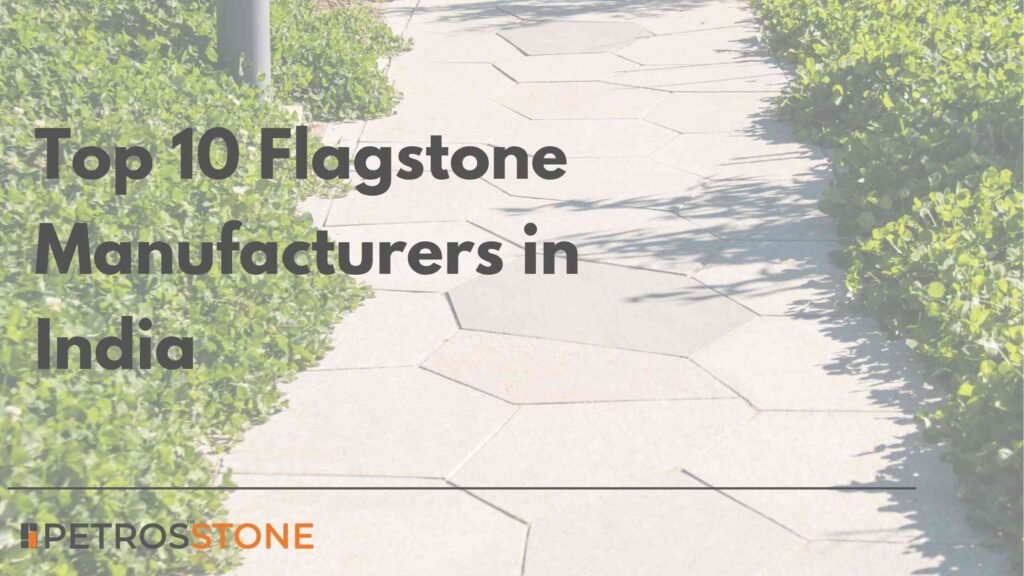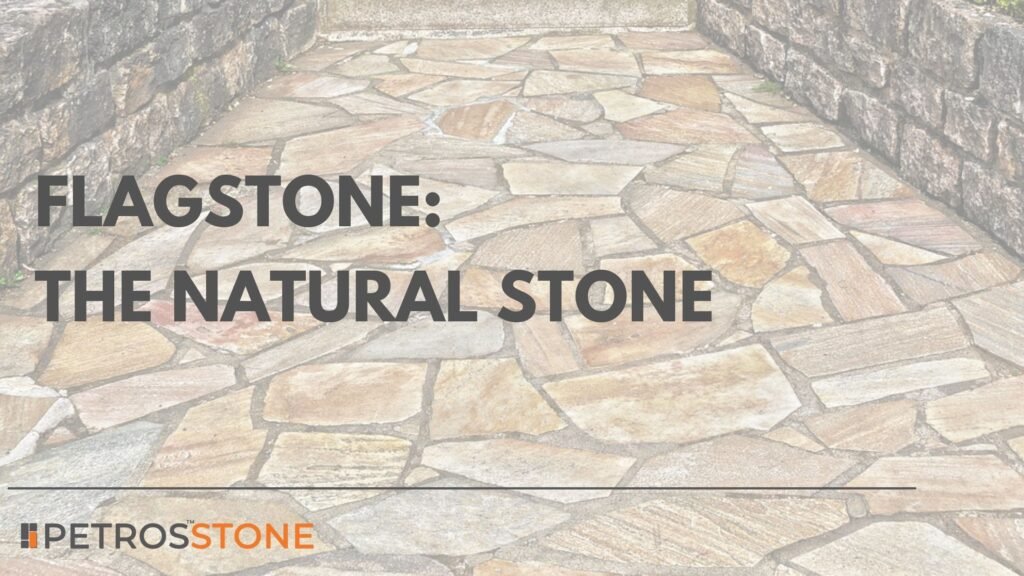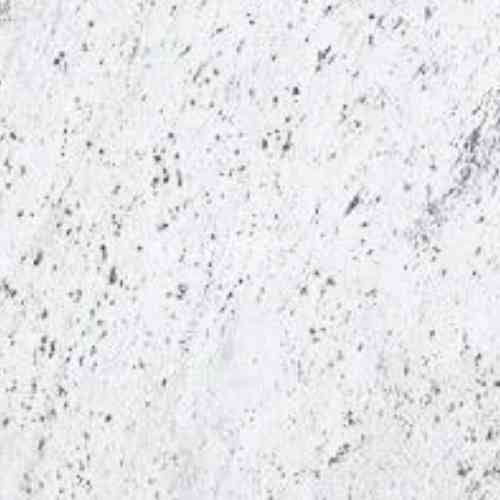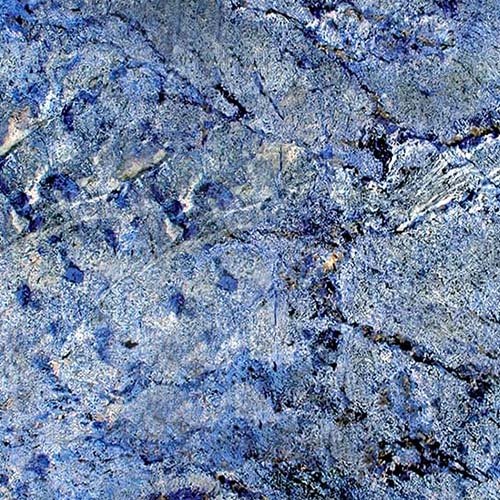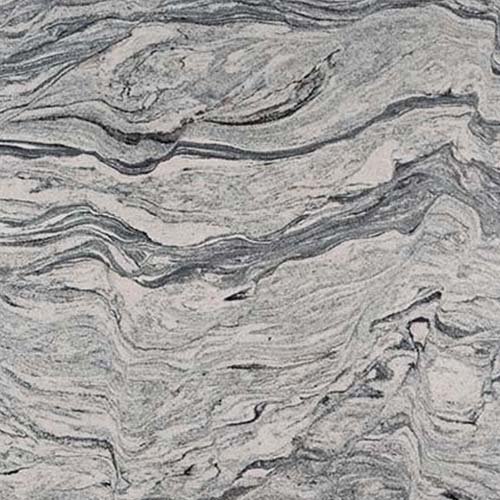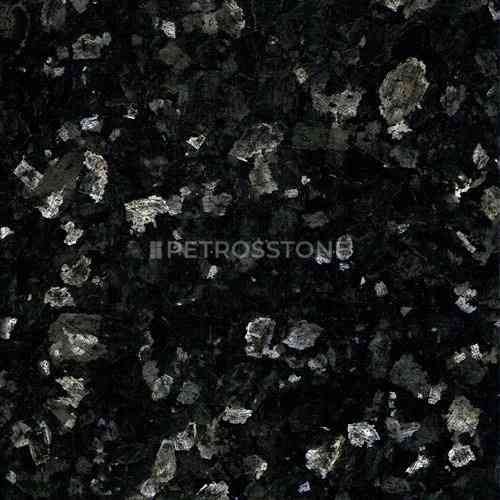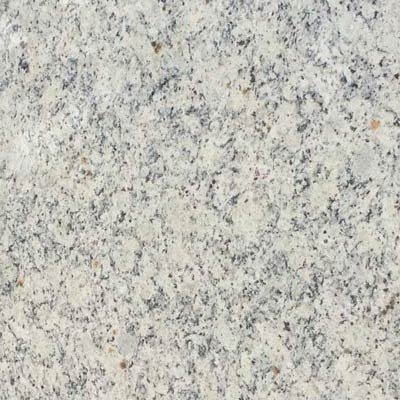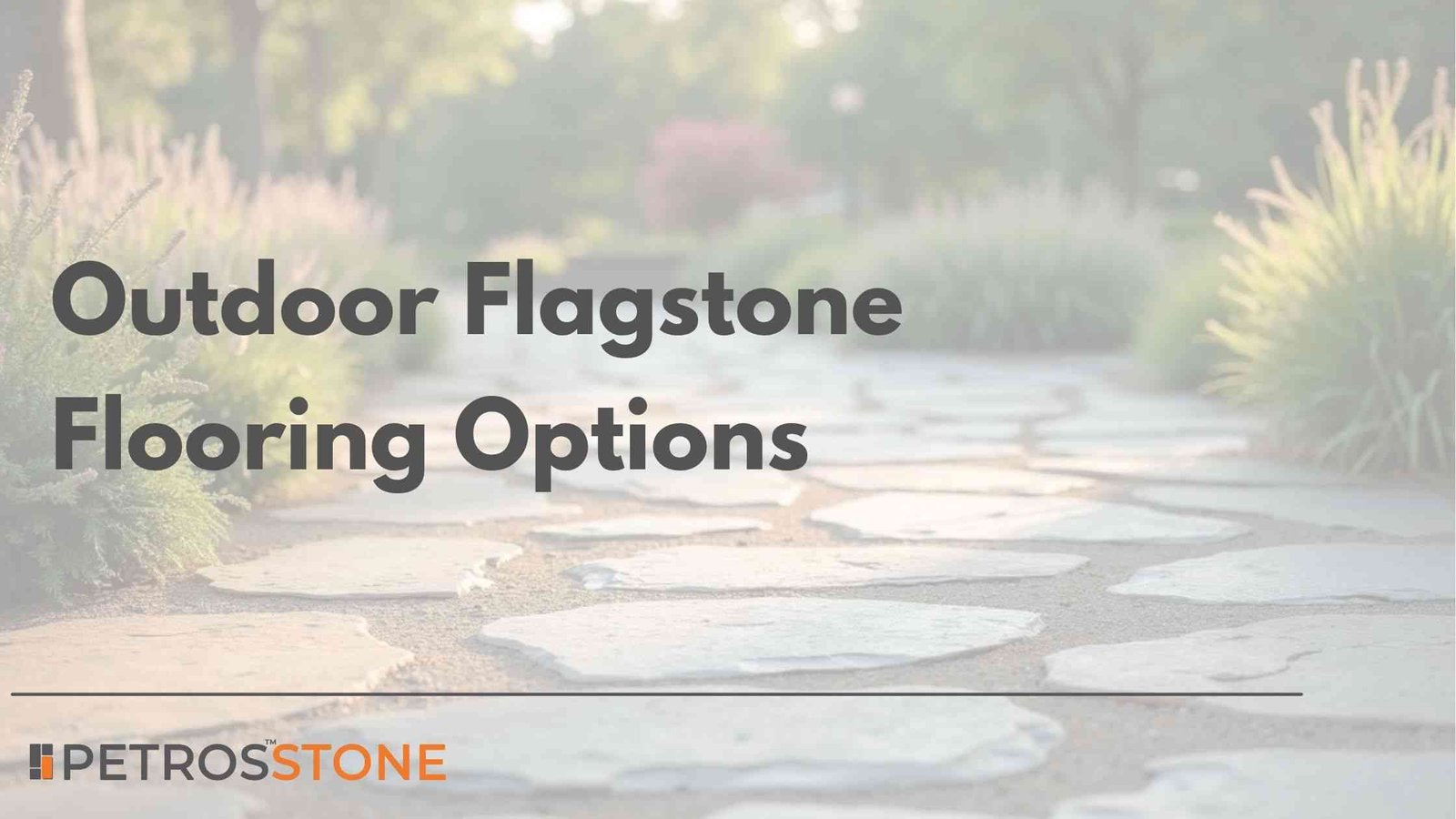
In this article, we explore the types, shapes, and installation methods of flagstone, along with essential maintenance tips and design ideas. We also compare irregular and cut flagstone, helping you choose the best option for your outdoor project in terms of style, budget, and functionality.
For centuries, flagstone has been a trusted choice for outdoor flooring, admired for its raw beauty, strength, and natural charm. Whether you’re designing a serene garden path, a rustic patio, or a welcoming pool deck, flagstone offers a timeless solution that blends durability with design freedom.
What makes flagstone truly unique is its ability to seamlessly integrate with outdoor landscapes, giving every surface a rugged, organic appeal. From cottages to contemporary homes, it fits in, and stands out, no matter the setting.
Laying Patterns (Flagstones)
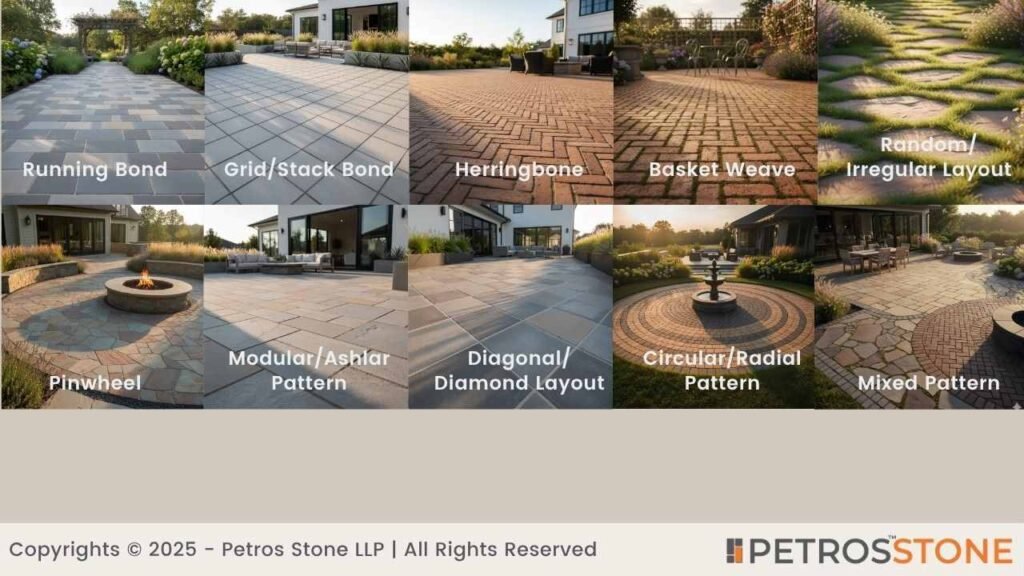
Common Types of Flagstone
| Type | Images | Appearance | Key Features |
| Sandstone | 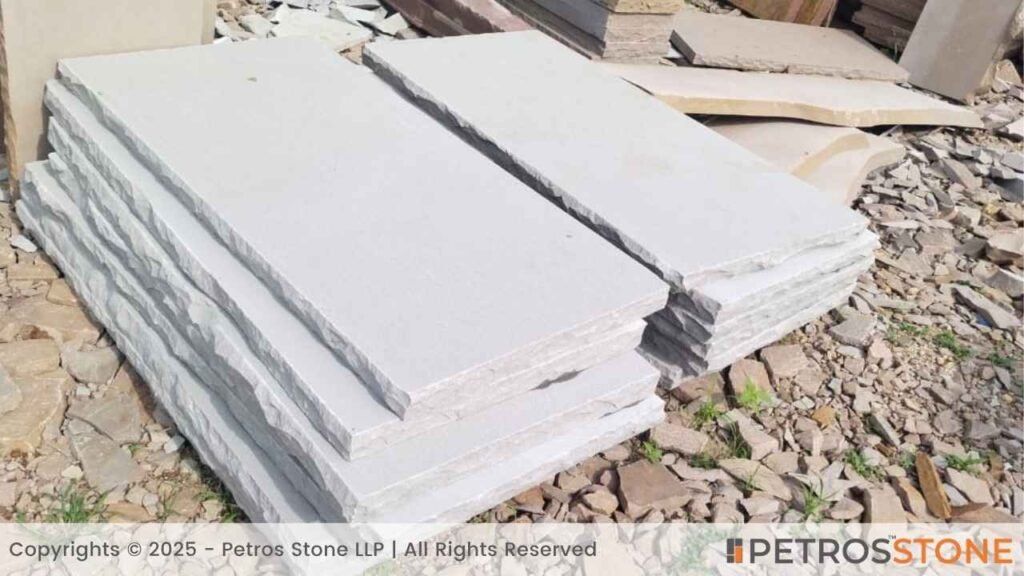 | Warm earthy colors, ranging from beige to reddish-brown | Soft and easy to cut, making it ideal for patios, walkways, and garden paths. Has a natural, rustic appeal. |
| Slate | 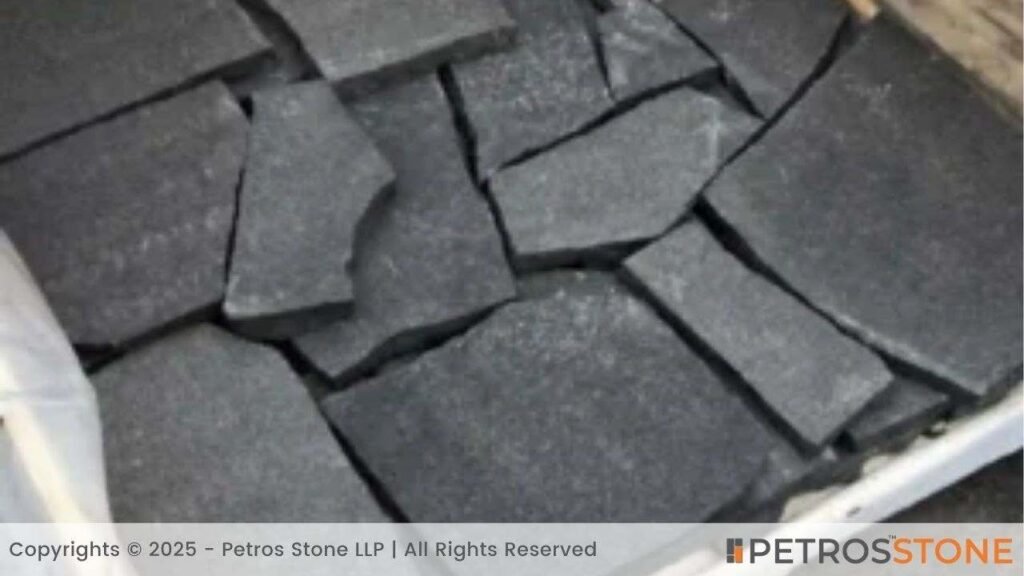 | Dark greys, greens, purples, sometimes black | Fine-grained and durable. Naturally slip-resistant, suitable for wet areas and pool surrounds. |
| Limestone | 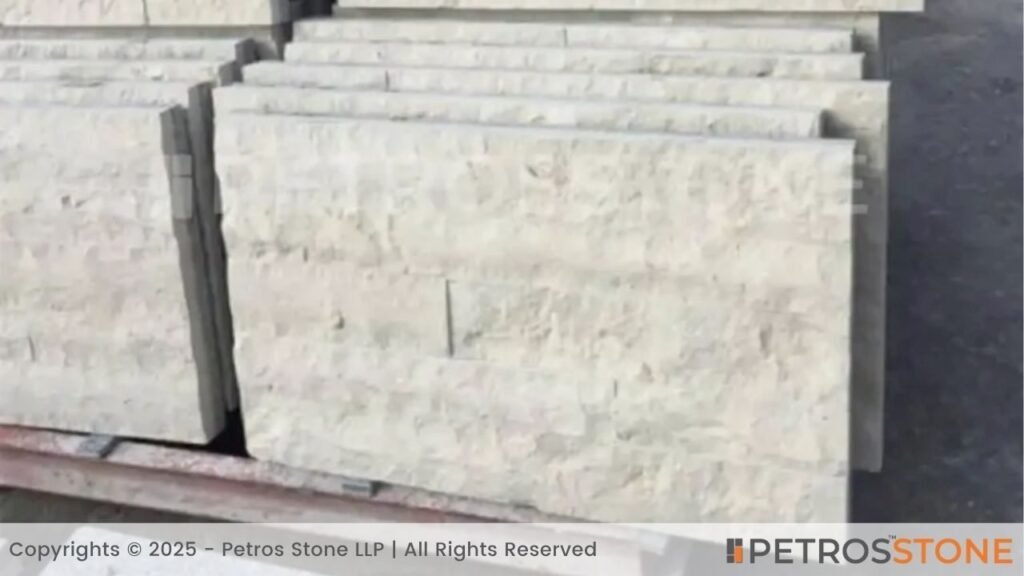 | Light cream to beige tones, smooth surface | Classic and elegant look. Easy to maintain and works well for patios, terraces, and formal outdoor spaces. |
| Bluestone | 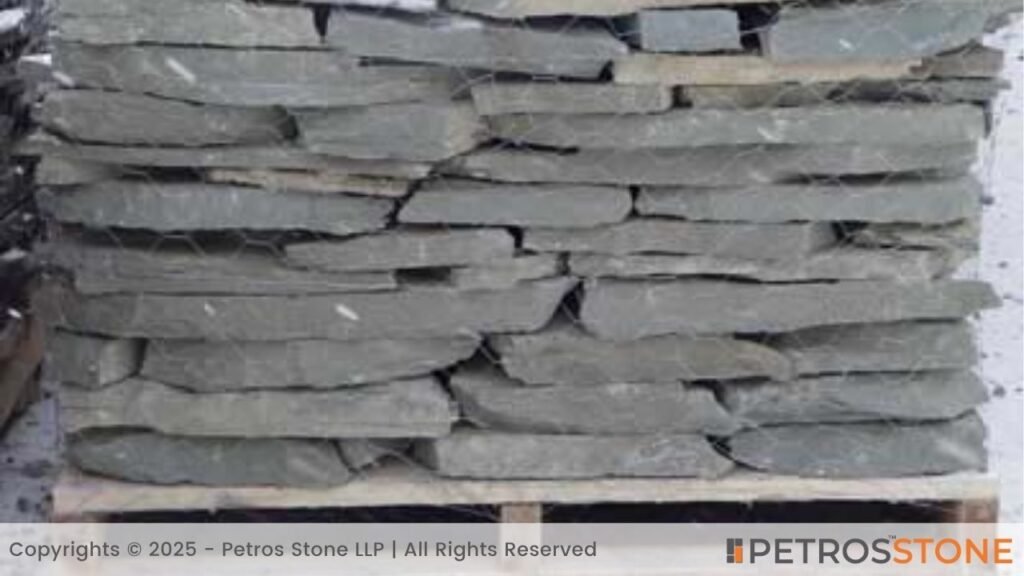 | Blue-grey shades, occasionally with hints of purple or green | Dense and strong. Highly versatile for patios, pool decks, and outdoor living areas. Weather-resistant. |
| Quartzite | 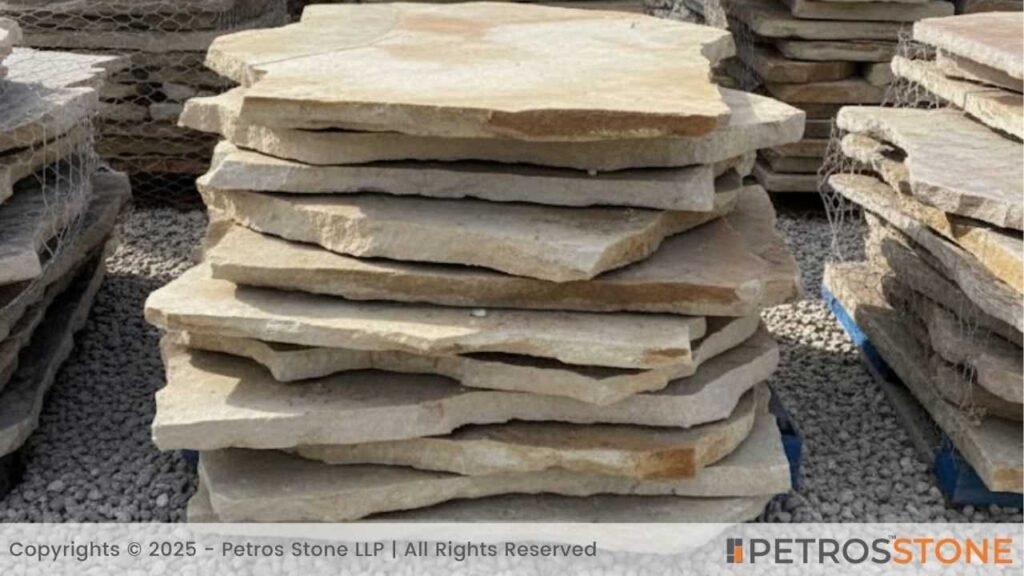 | Various shades, often sparkly with natural veining | Extremely hard and durable. Resistant to weather, frost, and heavy foot traffic, ideal for long-lasting outdoor use. |
- Laying Patterns (Flagstones)
- Understanding Flagstone
- Benefits of Flagstone Flooring
- Flagstone Shapes and Layout Options
- Irregular Flagstone Flooring
- Regular and Geometric Flagstone Flooring
- Laying Patterns (Flagstones)
- Creative Pattern Ideas with Flagstone
- Types of Outdoor Spaces Suited for Flagstone Flooring
- Installation Techniques
- Maintenance and Care of Flagstone Flooring
- Design Inspirations and Case Studies
- Sustainability and Eco-Friendly Aspects
- Pros and Cons of Different Flagstone Shapes
- Expert Tips and Recommendations
- Summary
- Key Takeaways
Understanding Flagstone
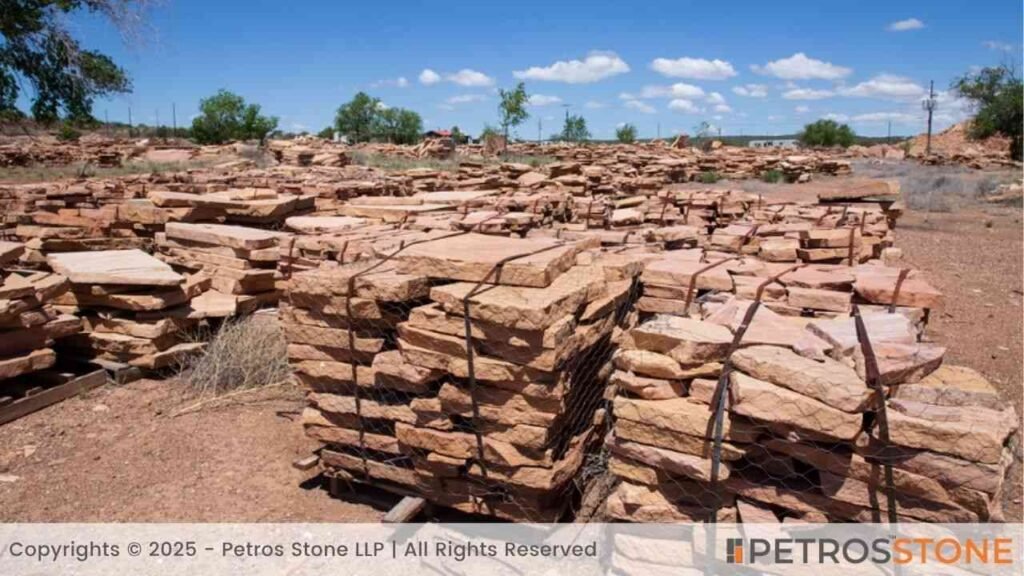
Definition and Key Features
Flagstone refers to a natural building material that is a special type of stone slab that is flat and has been employed as a paving surface. It is characterized by irregular shapes, rich colorings, and natural textures. Outdoors, functional and decorative applications can be made on Flagstone, and thus, it can be considered as one of the most versatile types of paving.
Key Features of Flagstone
| Feature | Description |
| Flatness | Ideal for walking surfaces |
| Natural textures | Rough, smooth, or cleft surfaces |
| Variety of colors | Earthy tones like beige, grey, brown, and blue |
| Durability | Long-lasting and weather-resistant |
| Versatility | Can be cut or used naturally |
Durability and Weather Resistance
The flagstone is naturally tough and thus suitable for harsh weather. Certain stones, such as quartzite and bluestone, are expensive to frost and water, but sandstone and limestone can be sealed against wet climates.
Natural Textures, Tones, and Versatility
The natural texture is one of the most appealing features of flagstone. Hewn surfaces with cracks or rough surfaces offer grasping and safety, whereas smooth surfaces offer a clean and professional appearance. Also, flagstone is available in various colors and can be harmonized with the nature of a garden, courtyard, or patio.
Common Types of Flagstone
Flagstone comes in a wide variety of looks and appearances:




Common Types of Flagstone
| Type | Appearance | Key Features |
| Sandstone | Warm earthy colors, ranging from beige to reddish-brown | Soft and easy to cut, making it ideal for patios, walkways, and garden paths. Has a natural, rustic appeal. |
| Slate | Dark greys, greens, purples, sometimes black | Fine-grained and durable. Naturally slip-resistant, suitable for wet areas and pool surrounds. |
| Limestone | Light cream to beige tones, smooth surface | Classic and elegant look. Easy to maintain and works well for patios, terraces, and formal outdoor spaces. |
| Bluestone | Blue-grey shades, occasionally with hints of purple or green | Dense and strong. Highly versatile for patios, pool decks, and outdoor living areas. Weather-resistant. |
| Quartzite | Various shades, often sparkly with natural veining | Extremely hard and durable. Resistant to weather, frost, and heavy foot traffic, ideal for long-lasting outdoor use. |
Benefits of Flagstone Flooring
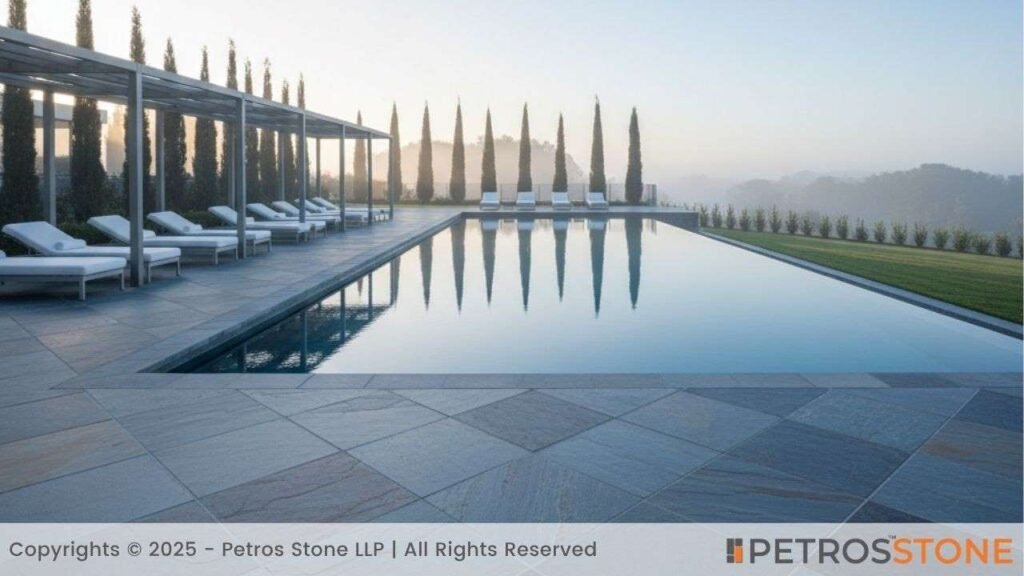
Aesthetic Value and Natural Appeal
Flagstone has a perennial and natural appearance. Outdoor spaces look elegant and natural with their natural patterns and earthy colors. It may be used along with many landscape designs, including rustic and modern.
Slip Resistance and Safety
The naturally textured surface on many flagstones is very slip-resistant. This allows them to be safer when used in locations that have moisture, such as outdoor side steps or stairs.
Climate and Space Adaptability
Flagstone is a water-trouper. It is resistant to heat, cold, rain, and even frost, which is why it is a secure outdoor flooring material. It can further be assimilated to fit into various outdoor areas such as gardens, patios, driveways, and terraces.
Low Maintenance Requirements
Flagstone has a low maintenance requirement. Sweeping frequently, washing every few years, and sealing normally suffice in keeping it in a fresh and sustainable look.
Sustainability and Eco-Friendly Qualities
Flagstone is natural and sustainable. Several suppliers provide locally found stones, reclaimed flagstones exist, and they minimize the environmental impact.
Flagstone Shapes and Layout Options
Irregular Flagstone for Rustic Looks
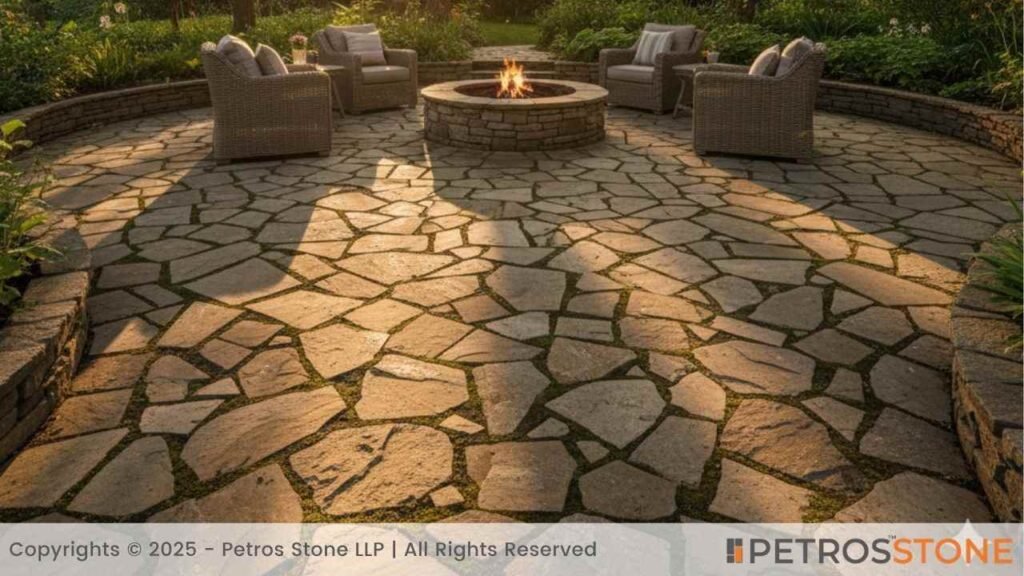
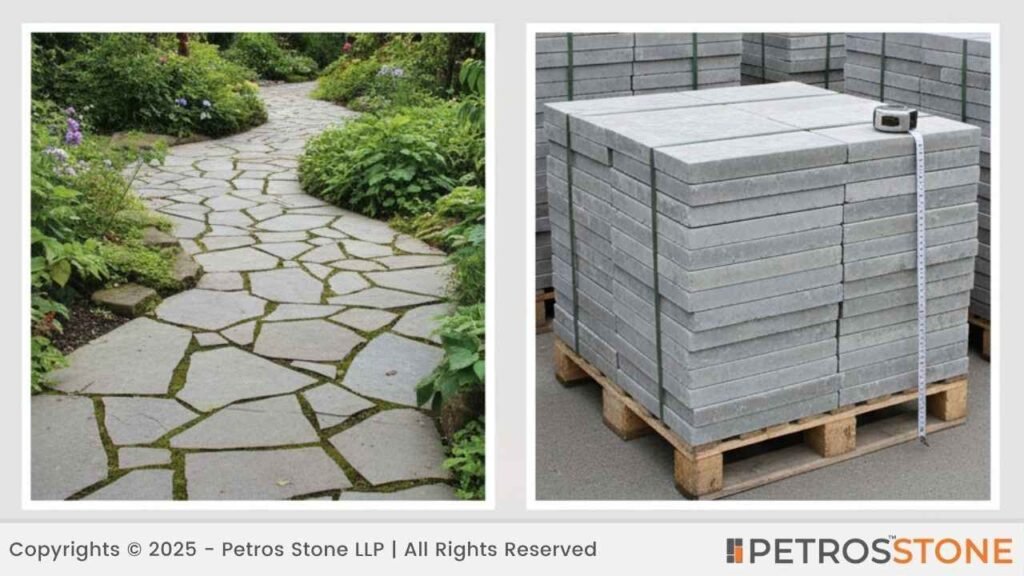
Irregular flagstones will be cut either naturally or minimally, producing organic forms that are puzzle-like. It is best used in rustic, informal areas and garden walks.
Cut, Rectangular, and Square Flagstone for Structure
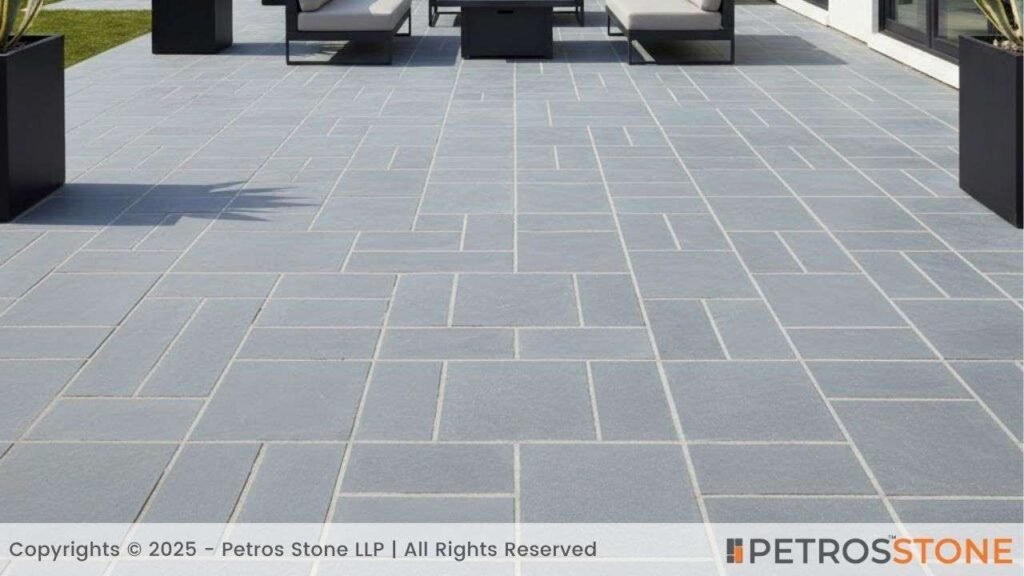
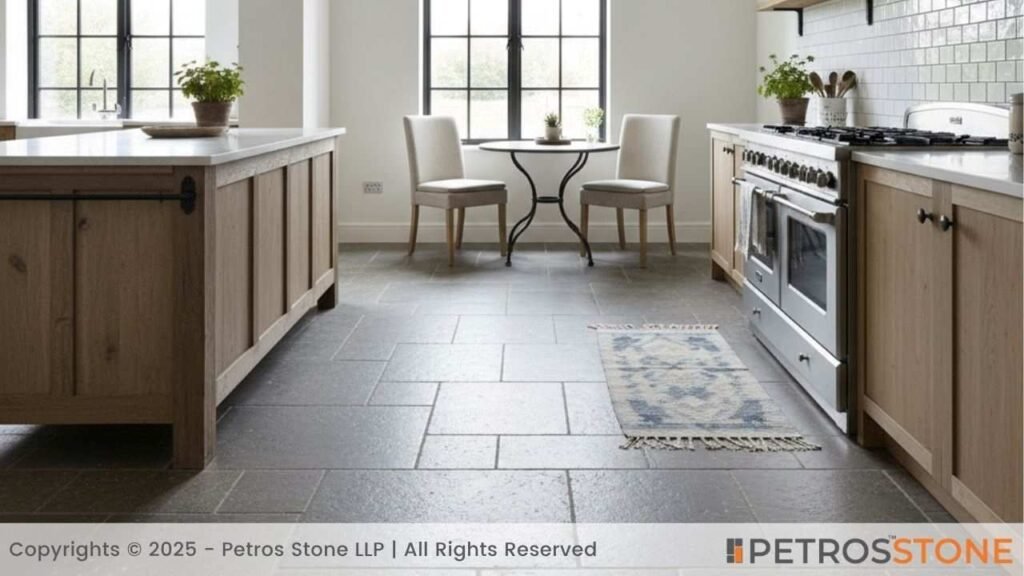
Square or rectangular flagstones are favorable, in case it is required to look formal or modern. They look clean and in order, and are simpler to lay in a standard manner.
Mixed Shape Installations for Creativity
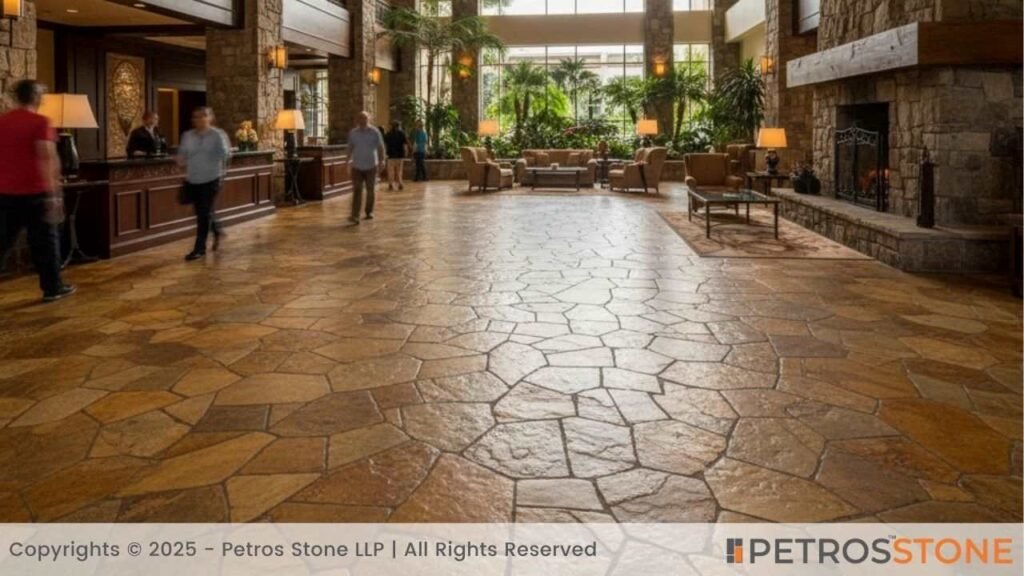
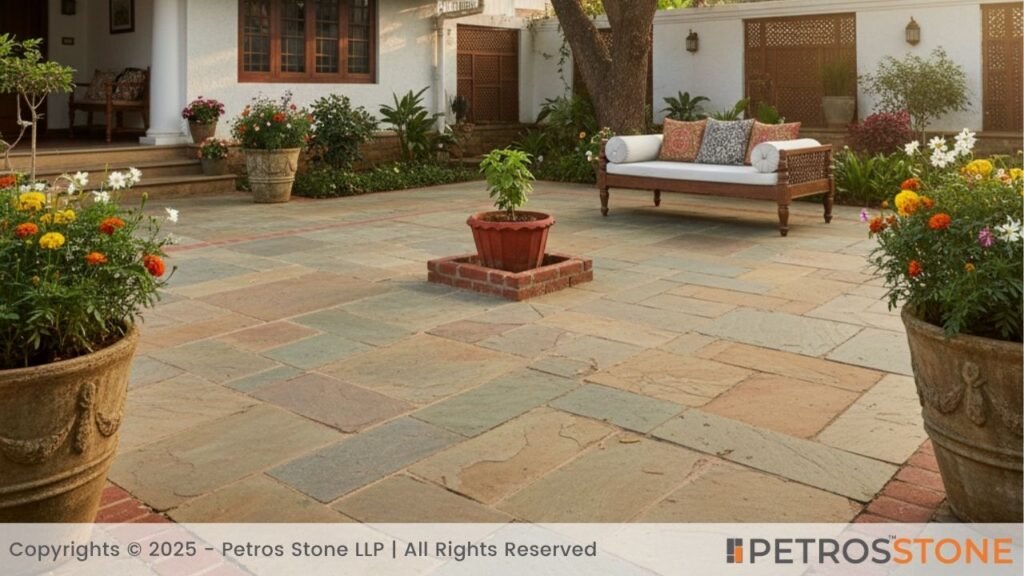
An irregular, cut flagstone combination makes it possible for unusual and imaginative designs. It can be used in any patio or courtyard where both formal and informal styles are needed.
Custom-Cut Flagstone for Unique Projects
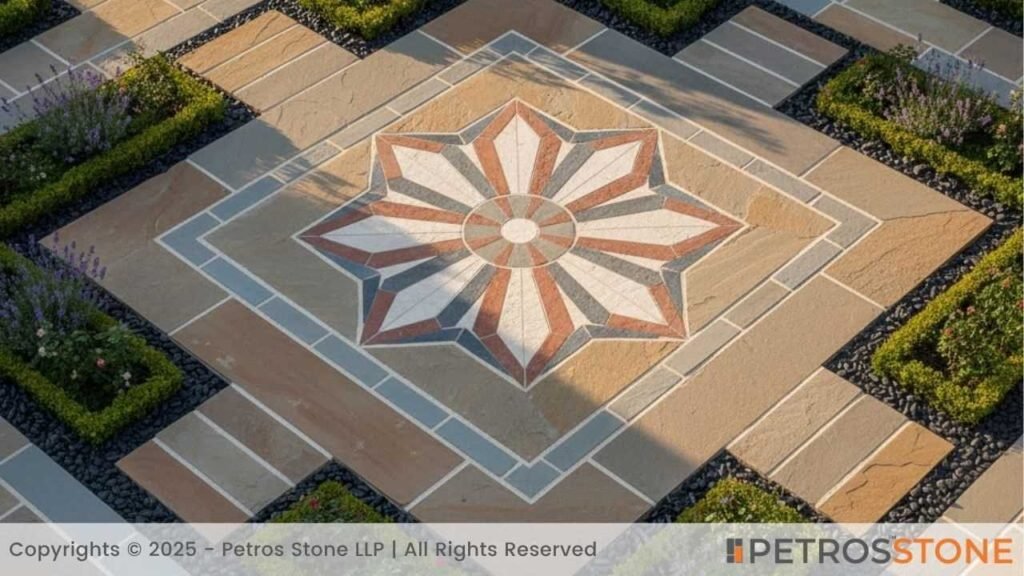
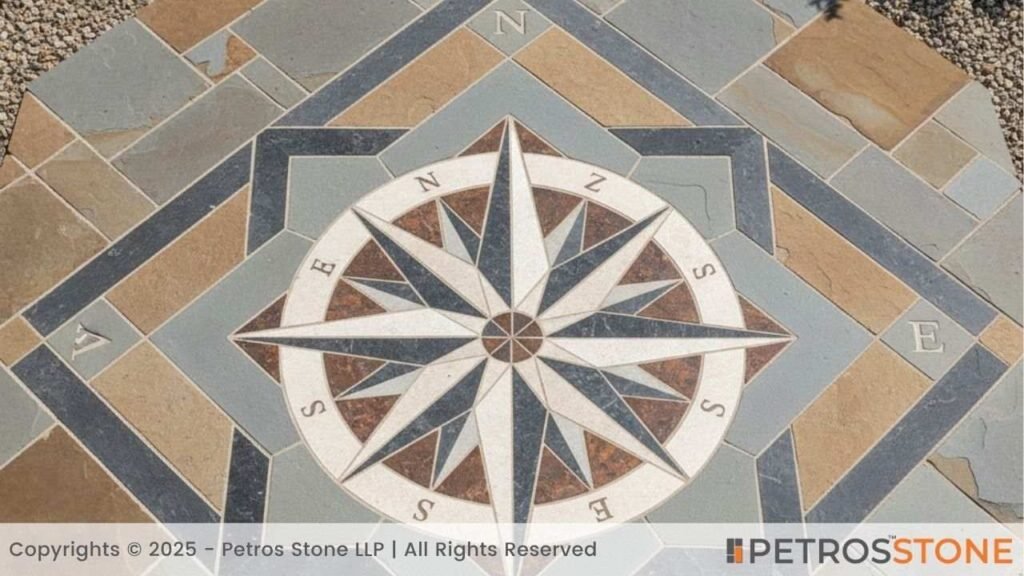
Tailored flagstones are custom-cut to precise dimensions or design. This product is perfect for special design projects such as mosaic or geometric layouts of gardens.
Irregular Flagstone Flooring
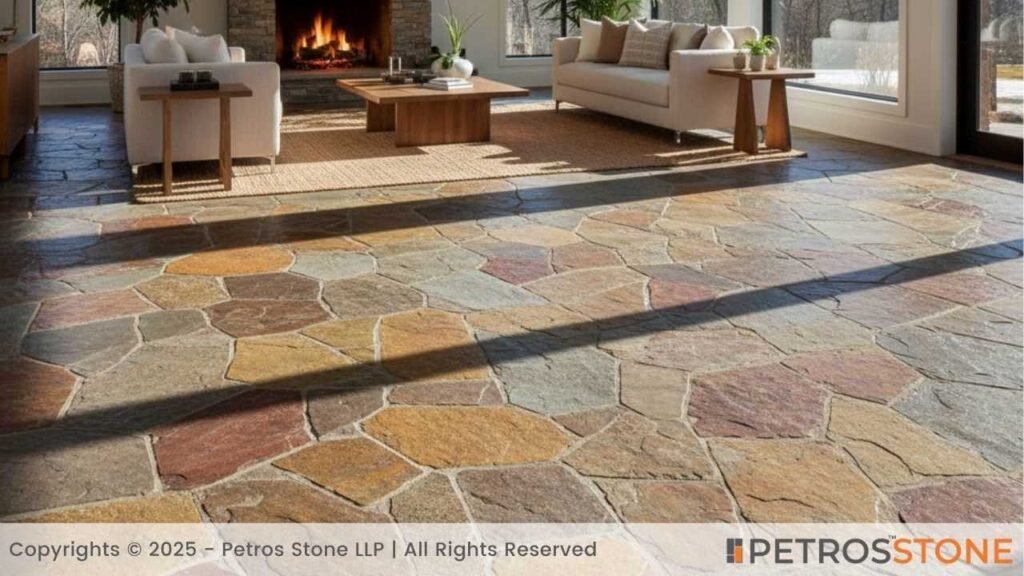
Characteristics of Irregular Shapes
Irregular flagstones are jagged and naturally manufactured. They tend to differ in terms of thickness, size, and texture, and make an outdoor setting appear more natural and relaxed.
Design Appeal – Organic and Informal Styles
Irregular patterns of flagstones give a natural, free-flowing design. They match gardenation, rocks, and plants, and create an attractive, organic, natural setting.
Installation Options – Dry-Laid vs. Mortar-Set
- Dry-Laid Method: Stones are laid on top of sand or gravel. This technique enables free drainage and simple substitution but needs careful leveling.
- Mortar-Set Method: materials are sewn with mortar to provide a surface that is stable and permanent. This best suits patios or high foot traffic.
Advantages of Irregular Flagstone
| Advantage | Explanation |
| Unique Appearance | Each stone has a distinct shape, color, and texture, creating a one-of-a-kind design that cannot be replicated. |
| Flexibility | Irregular stones can be fitted around curves, slopes, trees, and other garden features, allowing creative and organic layouts. |
| Natural Integration | Blends seamlessly with plants, rocks, and natural landscapes, giving a rustic and harmonious look. |
| Variety in Texture and Color | Offers multiple textures and earthy tones that enhance visual interest and depth in outdoor spaces. |
| Enhanced Drainage | Gaps between irregular stones allow water to drain naturally, reducing puddling and surface runoff. |
| Cost-Effective for Some Projects | Can use leftover or reclaimed stones, reducing material waste and overall cost. |
| Non-Slip Surface | Uneven surfaces provide natural grip, making it safer for wet areas like garden paths or near pools. |
| Eco-Friendly Option | Often sourced locally or reclaimed, minimizing environmental impact. |
| Versatile Design Possibilities | Can be used in patios, pathways, stepping stones, and decorative borders with custom layouts. |
| Low Maintenance | Minor settling or movement of stones doesn’t affect the overall appearance, making them easier to maintain over time. |
Best Outdoor Uses
1. Garden Paving: Paths made of broken stones are irregular forms that beautify the garden.
2. Casual Patios: Ideal in relaxed areas with rustic appearance.
3. Stepping-Stone Features: These are favored under the larger gardens to form focal points or pathways.
Challenges in Installing Irregular Pieces
- Close-fitting and adjusting.
- It may require more time than homogenized stones.
- Spaces might require special bonding materials such as sand or gravel.
Regular and Geometric Flagstone Flooring
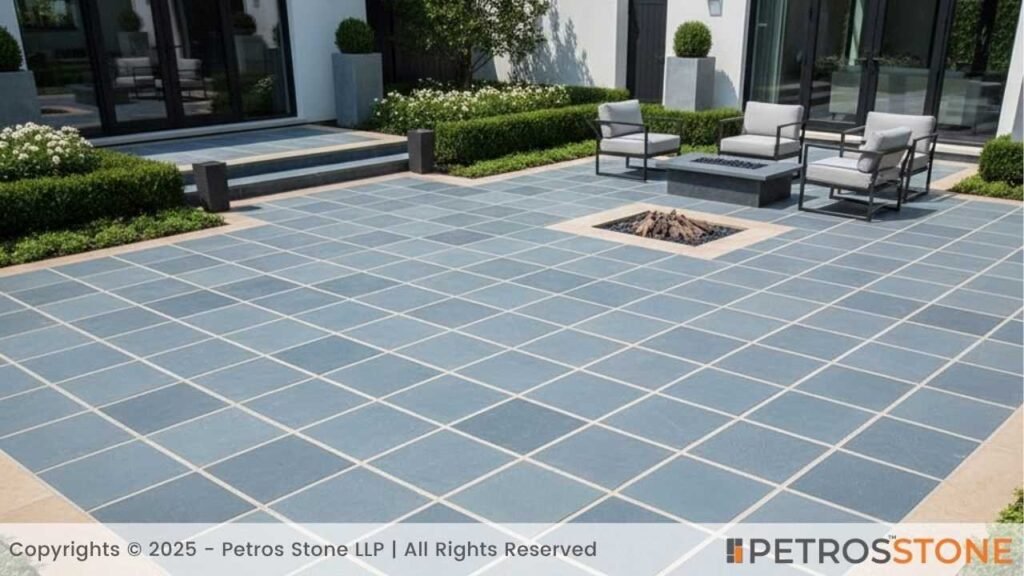
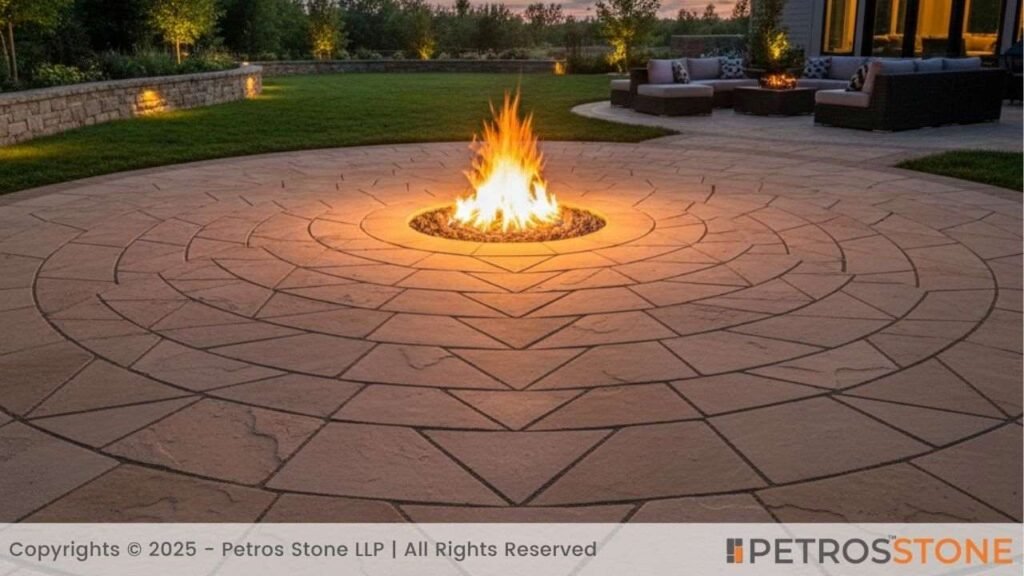
Square and Rectangular Stones
Precise stones are used to provide the same appearance and hence fit well in a formal garden, patio, or pathways.
Formal Appeal in Structured Spaces
Geometric stones provide a modern look that is clean and organized, which is appropriate in modern outdoor designs.
Ease of Installation Compared with Irregular Stones
Installation of cut stones is simpler because they are naturally fitted, saves on time, and jointing is up.
Laying Patterns (Flagstones)

Flagstone Laying Patterns
| Pattern | Description | Best Use / Effect |
| Running Bond | Staggered joints where each row is offset from the one below | Classic look, simple patios and walkways |
| Grid / Stack Bond | Stones are perfectly aligned in both horizontal and vertical rows | Modern, clean, formal outdoor spaces |
| Herringbone | Stones laid at 45° or 90° angles in a zigzag pattern | Stylish, dynamic appearance for patios, driveways, and walkways |
| Basket Weave | Pairs or sets of stones laid in alternating horizontal and vertical blocks | Adds texture and interest; traditional or cottage-style spaces |
| Random / Irregular Layout | Stones of different sizes and shapes fitted together naturally | Rustic, organic gardens and informal patios |
| Pinwheel | A small square stone is surrounded by larger rectangular stones forming a rotating pattern | Decorative focal areas, garden corners, or entrances |
| Modular / Ashlar Pattern | Stones of varying sizes but cut to a consistent thickness, arranged in repeating patterns | Balanced look with subtle variation, suitable for modern and traditional patios |
| Diagonal / Diamond Layout | Stones laid at 45° to the edges of the space | Makes small spaces appear larger, adds visual interest |
| Circular / Radial Pattern | Stones arranged in concentric circles or arcs | Ideal for round patios, fountain surrounds, or focal points |
| Mixed Pattern | A combination of different patterns and shapes | Creative, custom designs for unique outdoor aesthetics |
Creative Pattern Ideas with Flagstone
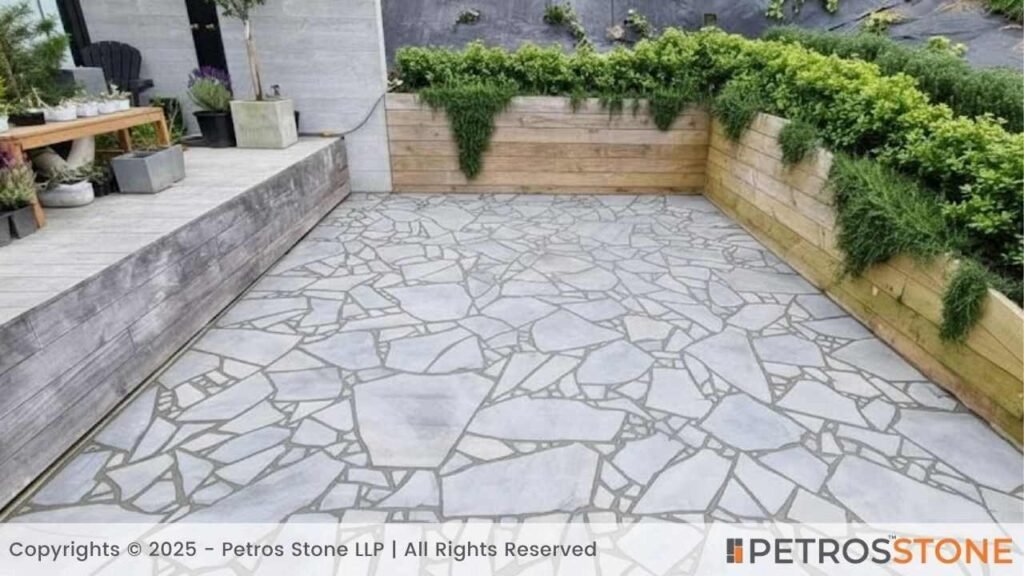

Crazy Paving with Irregular Shapes
Crazy paving uses irregular stones to create free-form patterns. It is highly versatile and suits informal areas.
Mixed Irregular and Cut Stone Designs
A mixture of natural stones and cut stones provides both organic and structural elements in the same layout.
Mosaic-Style Arrangements with Small Pieces
They can be used to create artistic stone mosaics made out of small flagstones, which could easily be used in decorative patios/courtyards.
Borders and Contrasting Edges
Contrasting stones in borders can be used to demarcate spaces, introduce elegance, and prevent the dislocation of stones.
Integrating Flagstone with Gravel, Grass, or Pebbles
- Grass joints add greenery between stones.
- Pebbles or gravel form drainage and a natural appearance.
- This assimilation adds to the beauty and functionality.
Types of Outdoor Spaces Suited for Flagstone Flooring
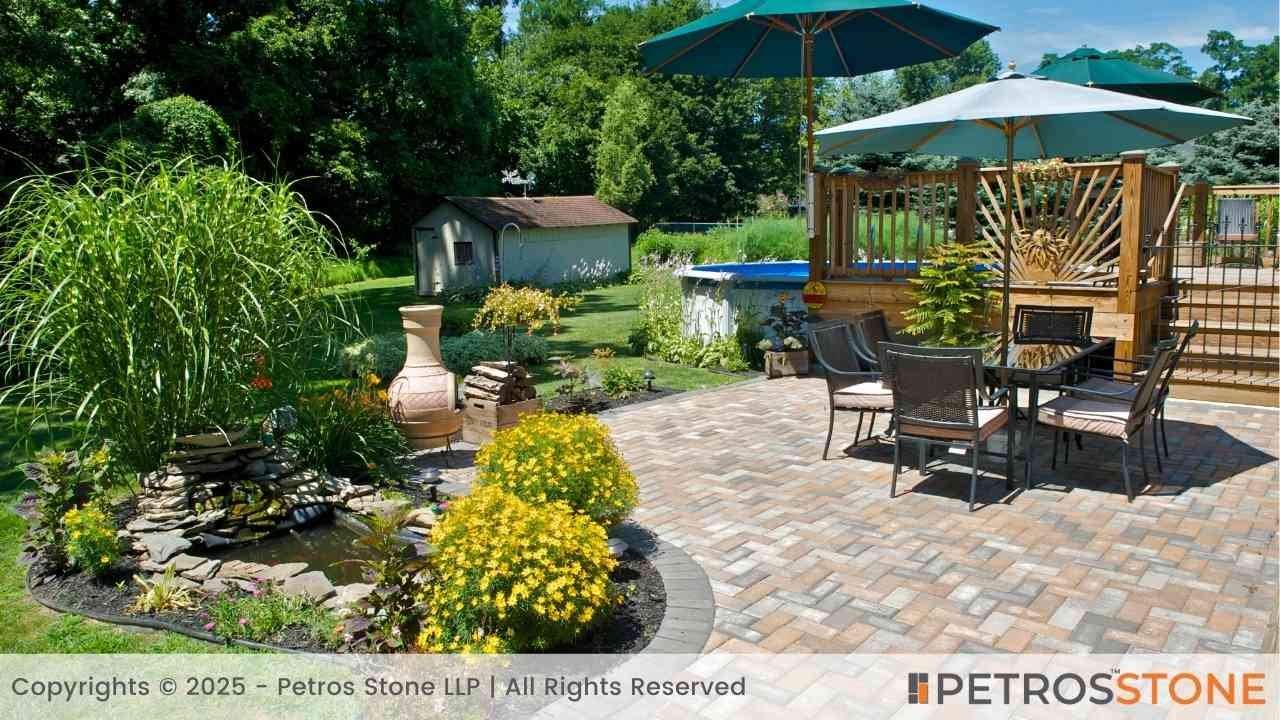
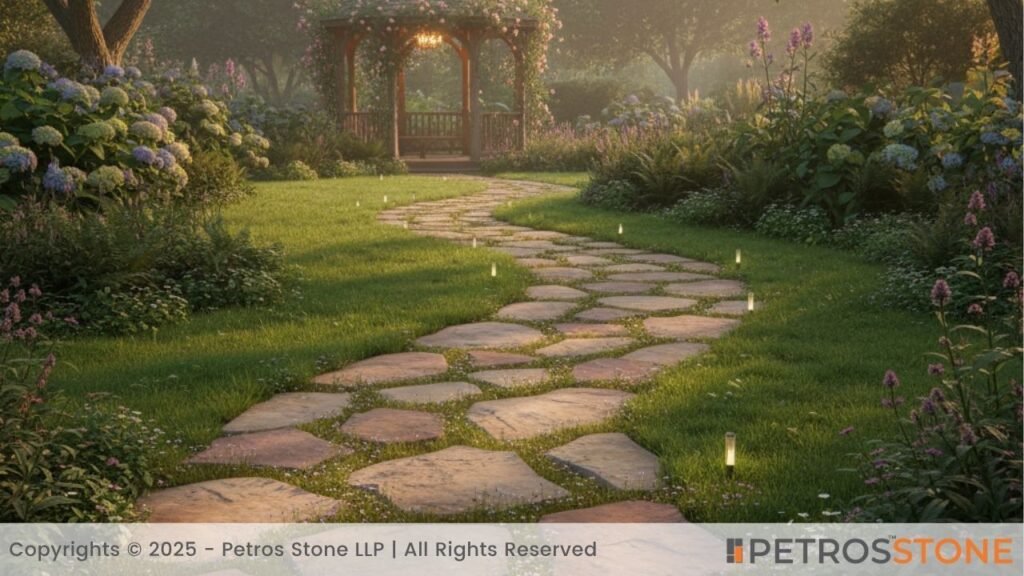
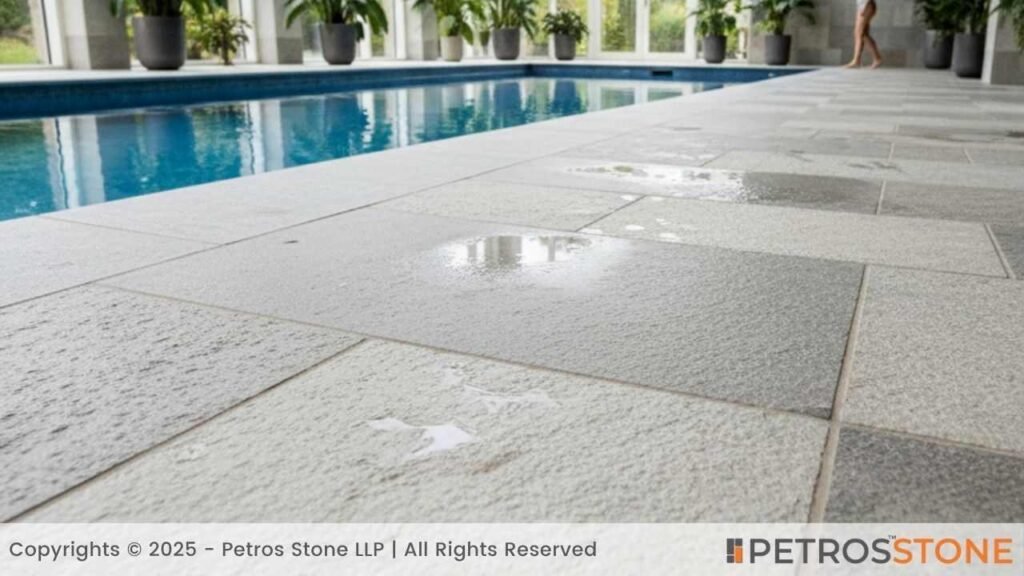
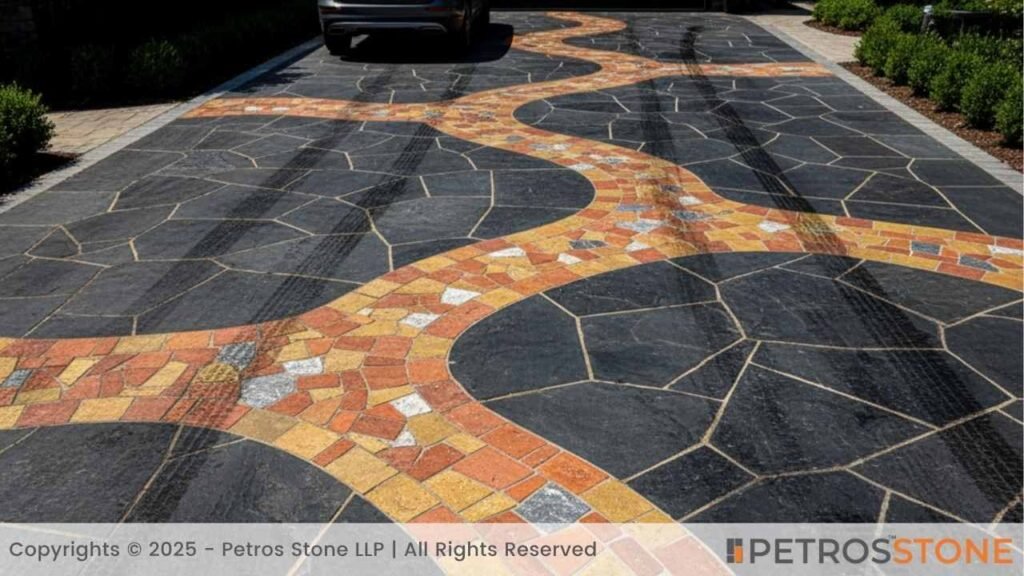
Outdoor Spaces Suited for Flagstone Flooring
| Outdoor Space | Recommended Flagstone Type | Features & Advantages | Ideal Layouts & Patterns |
| Patios | Bluestone, Sandstone, Limestone | Durable, visually appealing, suitable for outdoor seating areas; offers natural textures and warm tones | Can be laid in running bond, grid, or herringbone patterns for formal or casual styles |
| Garden Pathways | Irregular or small flagstone | Creates natural, organic trails; blends well with plants and landscaping; easy to fit around curves and features | Random or crazy paving arrangements to emphasize an informal, rustic look |
| Pool Decks | Slip-resistant slate or quartzite | Provides safe walking surfaces around water; resistant to moisture, heat, and weathering | Can be arranged in geometric patterns or irregular layouts to complement the pool design |
| Courtyards | Mixed shapes or custom-cut stones | Allows creative, artistic designs; can integrate mosaics or borders; adds unique character | Combines formal and informal layouts for a balanced aesthetic |
| Driveways | Dense, durable stones like quartzite or bluestone | Handles heavy loads; long-lasting; resists cracking and wear | Typically laid in grid or running bond patterns for stability and an even surface |
Installation Techniques
Dry-Laid vs. Wet-Laid Methods
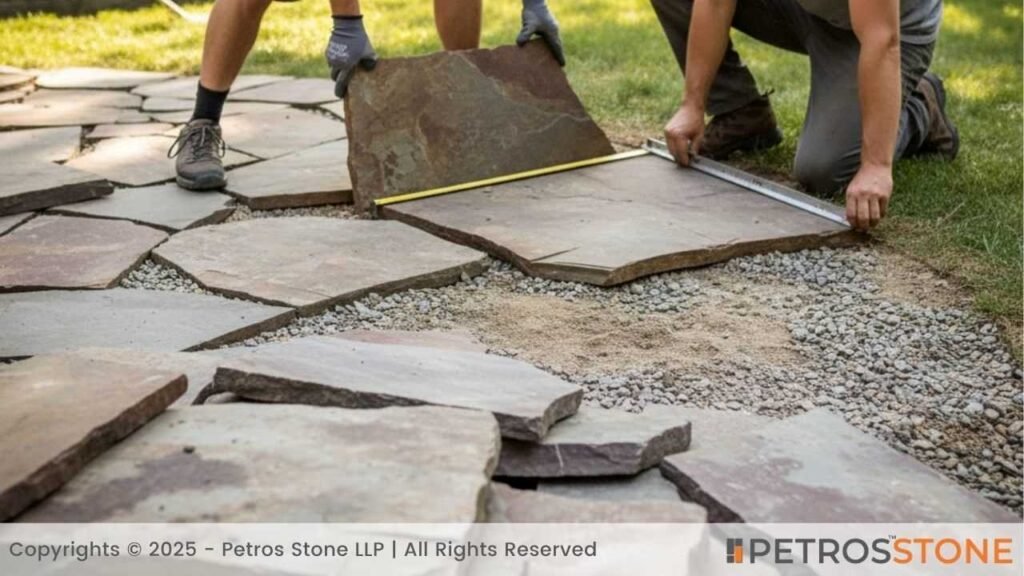
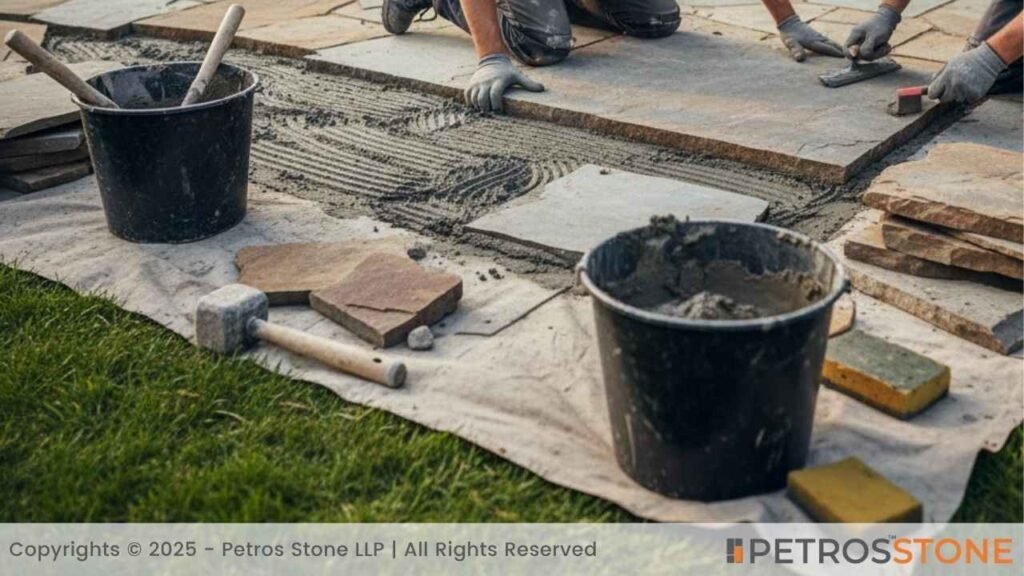
Pros and Cons of Dry-Laid and Wet-Laid Installation
| Method | Pros | Cons |
| Dry-Laid | Allows water to drain naturally between the stones, reducing puddles and potential water damage. Stones can be easily lifted and replaced if needed, making repairs simple and cost-effective. | Because stones are not fixed with mortar, the surface may shift or become uneven under heavy foot traffic or furniture. Requires careful leveling during installation to prevent tripping hazards. |
| Wet-Laid | Stones are set permanently in mortar, providing a solid, stable surface suitable for patios, driveways, and other high-traffic areas. Offers a neat, uniform appearance that holds up well over time. | Installation is more labor-intensive, requiring additional time and skill. Initial costs are higher due to mortar, materials, and professional installation in most cases. Once set, stones are difficult to adjust or replace. |
Base Preparation for Durability
- Dig the hole with the desired depth.
- Add gravel and compact to allow drainage.
- For leveling, lay a mortar base or sand.
Tools and Materials Required
- Shovel and rake
- Level and rubber mallet
- Gravel, sand, or mortar
- Jointing materials (sand, gravel, or mortar)
Jointing Options
| Type | Images | Description | Use Case | Advantages | Considerations |
| Grass Joints | 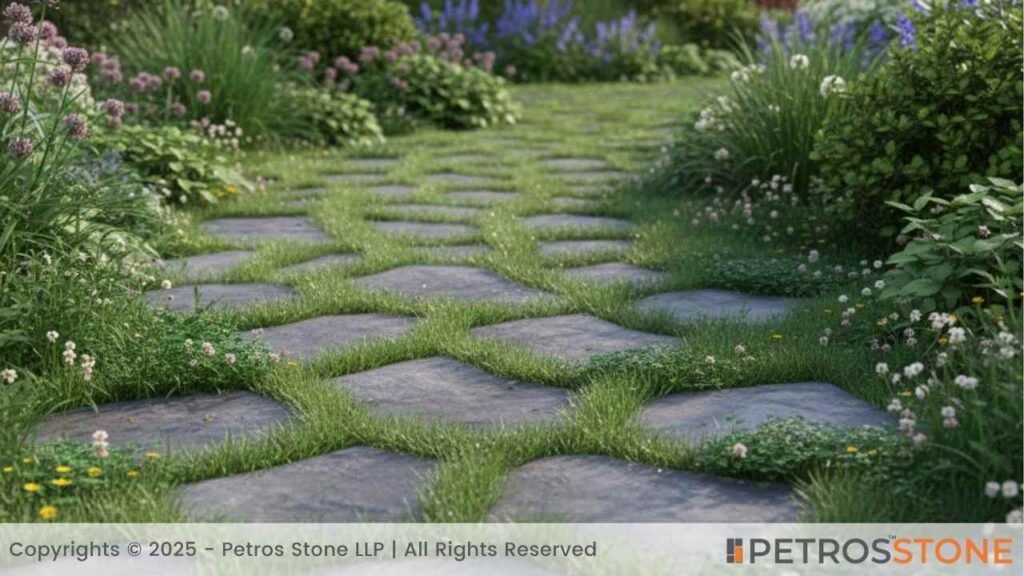 | Spaces between flagstones are filled with grass or low-growing plants. | Natural look, garden paths | Creates a soft, green appearance; integrates well with landscapes; promotes natural drainage | Requires regular mowing and care; may not be suitable for heavy foot traffic |
| Sand Joints | 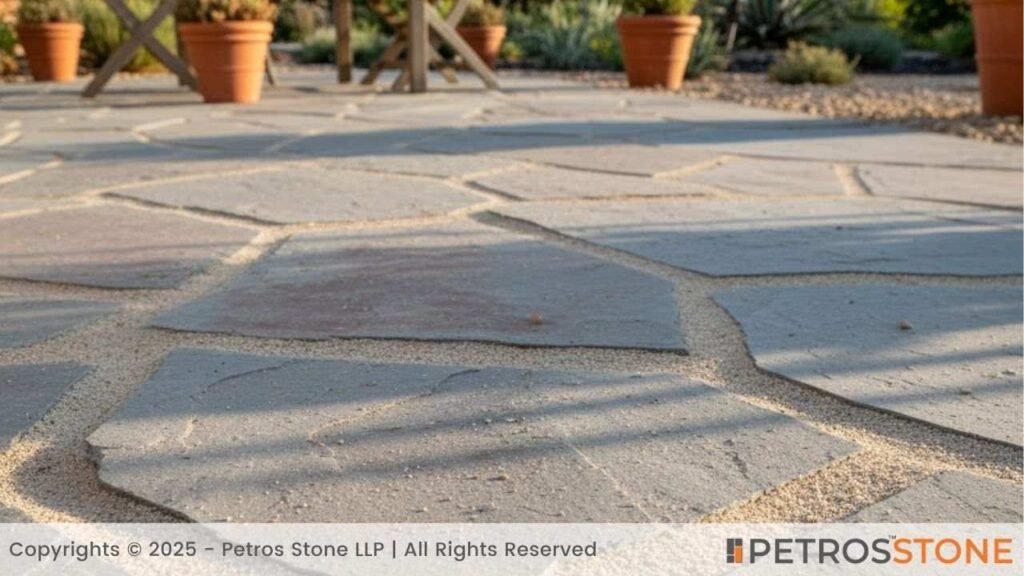 | Gaps between stones are filled with sand, often compacted. | Flexible and low-cost | Easy to install and maintain; allows slight stone movement; inexpensive | Can wash away over time in heavy rain; may require periodic replenishment |
| Mortar Joints | 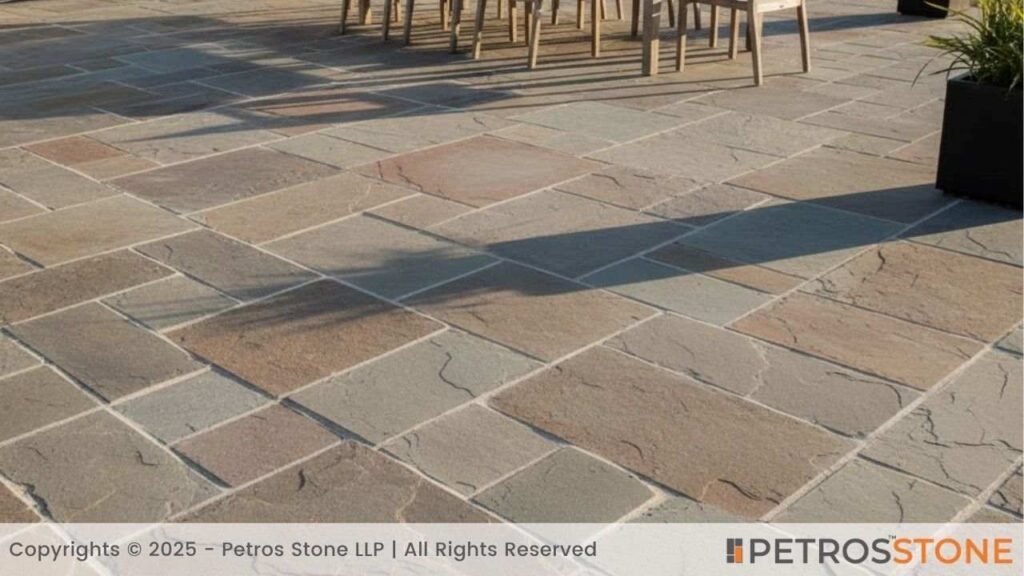 | Stones are fixed with mortar to create a solid, permanent surface. | High-traffic areas, patios | Strong, durable, and long-lasting; prevents weeds from growing in joints | Labor-intensive installation; harder to repair individual stones; can crack over time with extreme temperature changes |
Tips for Fitting Irregular Stones
- Begin at a fixed corner/edge.
- Test-fit before complete placement.
- Fill gaps with sand, gravel, or mortar.
Professional Installation vs. DIY
- Small areas of medium difficulty can be completed as DIY.
- Professional installation guarantees reliability and flawless installation, particularly for large patios or complicated designs.
Maintenance and Care of Flagstone Flooring
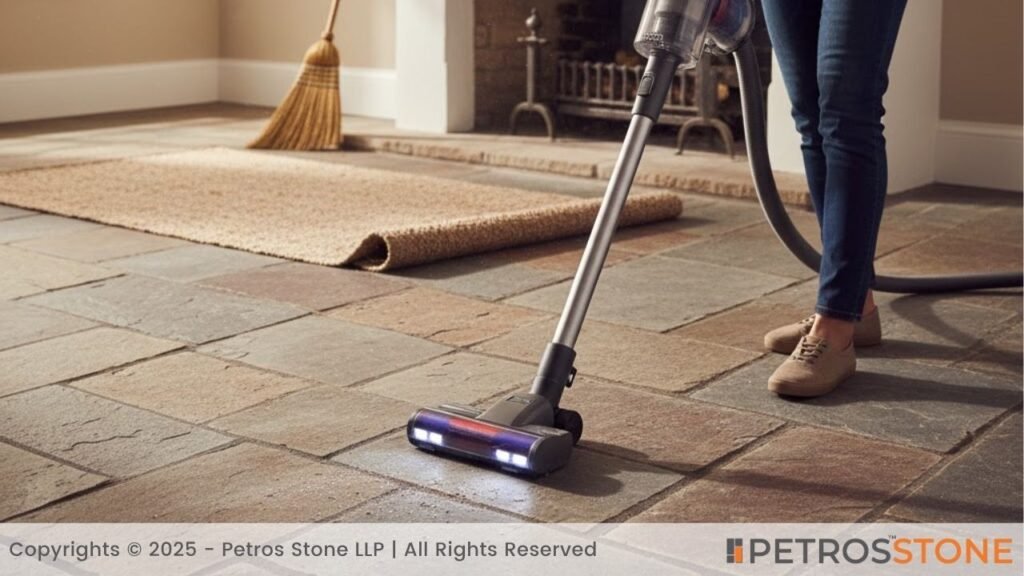
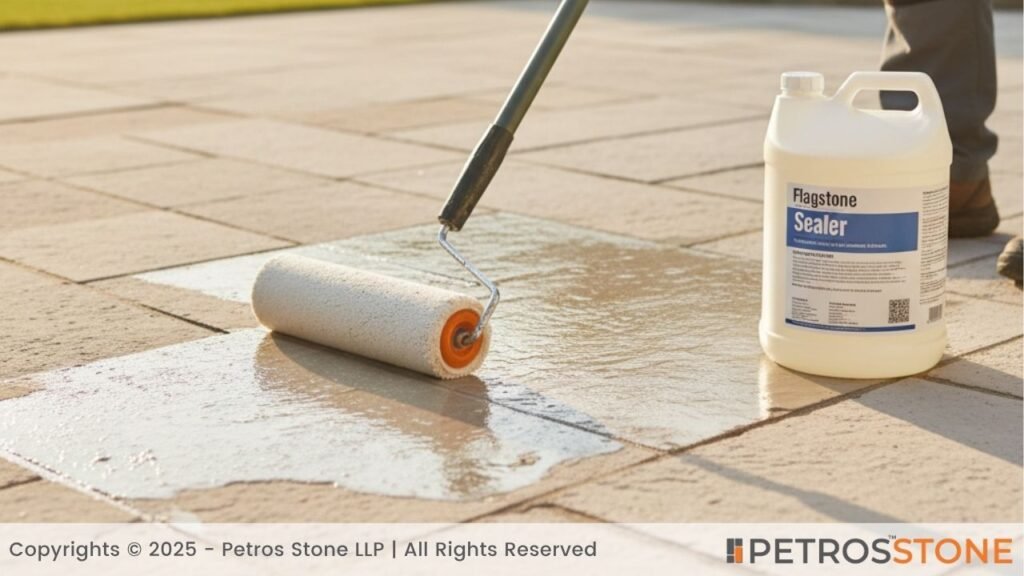
Regular Cleaning and Upkeep
- Sweep debris regularly.
- Clean with water and mild detergent when necessary.
Preventing Moss, Mold, and Stains
- Apply pressure washing to mosses.
- Coat surfaces with environmentally-friendly anti-moss solutions.
Sealing Options for Protection
- Sealants inhibit the entry of water, staining, and fading.
- Resealed after 2-3 years based on weather exposure.
Repairing Damage or Loose Stones
- Lift and reset loose stones.
- Replaced damaged or broken stones with similar materials.
Seasonal Care for Different Climates
- De-icing salts are harmful to stones and should be avoided in cold climates.
- Whether a hot or cold climate, watch for surface cracks due to expansion.
Cost Considerations
| Cost Factor | Irregular Flagstone | Cut/Rectangular Flagstone | Notes / Considerations |
| Material Price | Moderate to high; depends on stone type and size | Slightly higher due to cutting and uniformity | Natural irregular stones may cost less if locally sourced or reclaimed |
| Installation & Labor Charges | Higher; requires fitting irregular shapes, more time, and precise leveling | Moderate; easier and faster to install due to uniform shapes | Labor costs may vary by region; DIY is possible for small areas |
| Base Preparation Cost | Slightly higher; irregular stones may need customized leveling | Standard base preparation suffices | A proper base is crucial for durability |
| Long-Term Durability & Value | High, natural look ages well and adds character | High, formal look remains consistent over time | Sealing improves lifespan; both can last decades if maintained |
| Maintenance Cost | Moderate; occasional reseating, cleaning, sealing | Low to moderate; easier to clean and maintain | Irregular joints may collect more debris or moss |
| Affordability | Medium; depends on source and installation complexity | Medium-High; more uniform stones cost slightly more | Budget planning should include labor, base, and sealing |
| Budget-Friendly Alternatives | Reclaimed irregular stones, local sandstone, and mixed gravel integration | Stamped concrete or engineered stones imitating cut flagstone | Alternative options reduce costs while maintaining aesthetics |
| Additional Costs | Jointing material (sand, gravel, or mortar), edging | Same; less joint adjustment needed | Mortar-set installations cost more than dry-laid installations |
Budget-Friendly Alternatives: Use reclaimed stones, local sandstones, and integrations of mixed gravel are cheaper alternatives.
Flagstone Alternatives for Outdoor Flooring
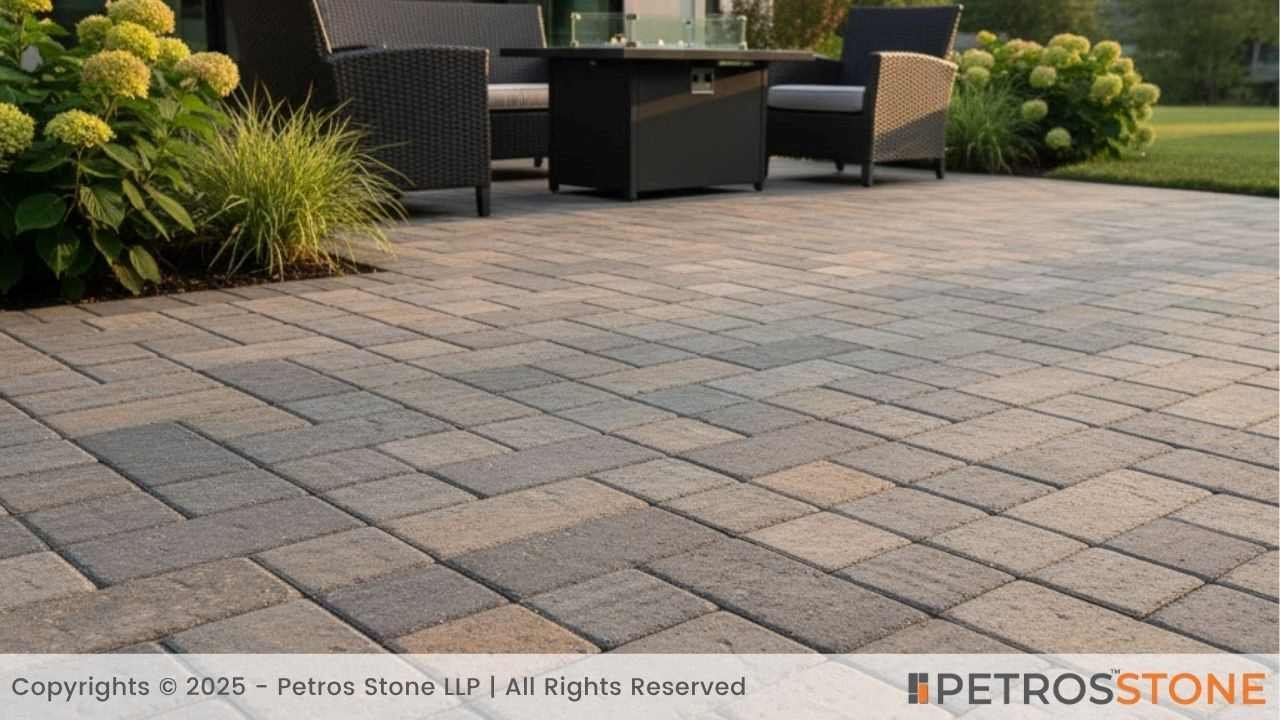
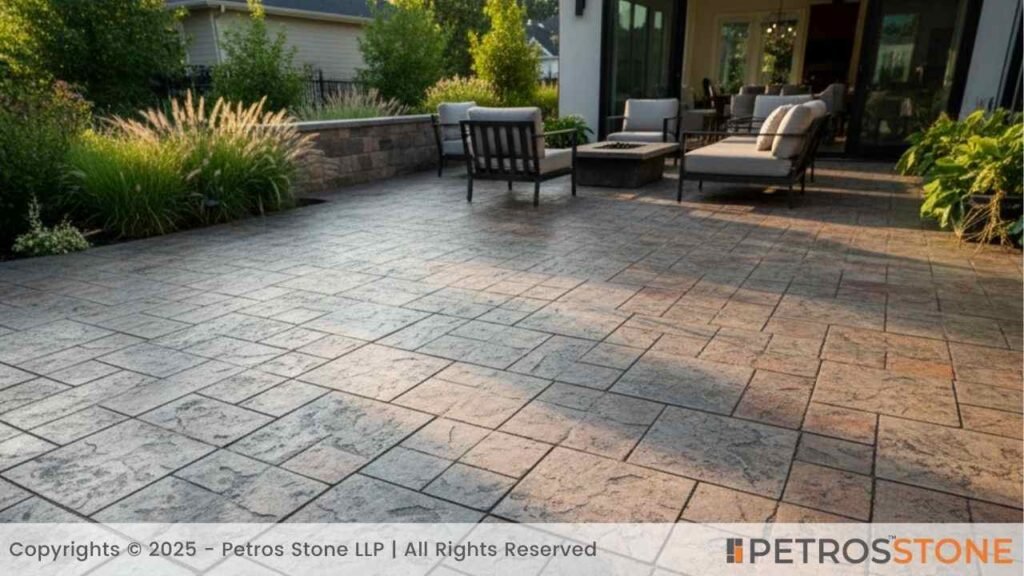
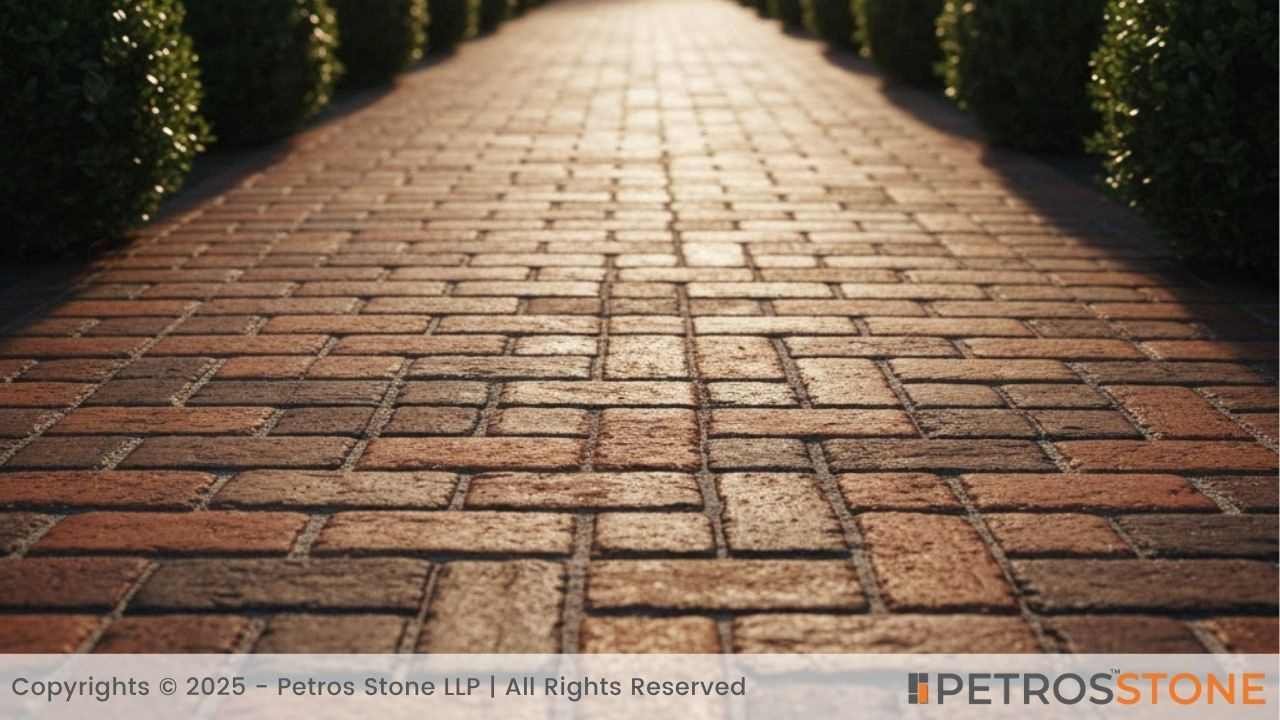
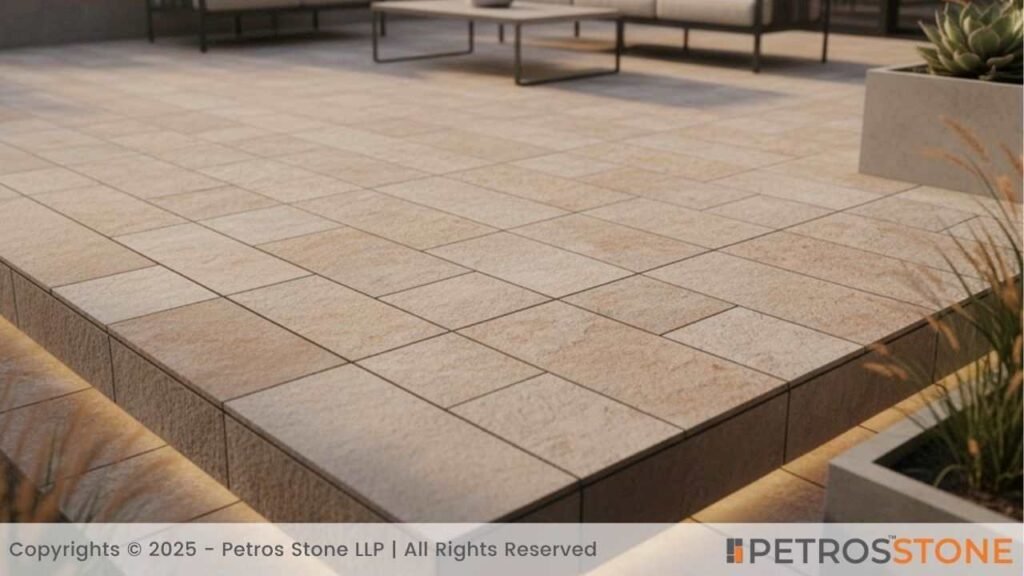
Flagstone Alternatives for Outdoor Flooring
| Alternative | Features |
| Concrete Pavers | Can mimic the appearance of natural flagstone; durable, affordable, and available in a wide range of colors and sizes; easy to replace if damaged. |
| Stamped Concrete | Offers versatile designs that resemble natural stone, brick, or tile; low maintenance; provides a continuous surface without joints; durable for high-traffic areas. |
| Brick and Clay | Classic, timeless appearance with warm tones; strong and long-lasting; resistant to fading; suitable for patios, walkways, and driveways. |
| Composite/Engineered Stone | Lightweight and easy to install; consistent colors and textures; low maintenance; often designed to withstand harsh weather conditions while mimicking natural stone aesthetics. |
Design Inspirations and Case Studies
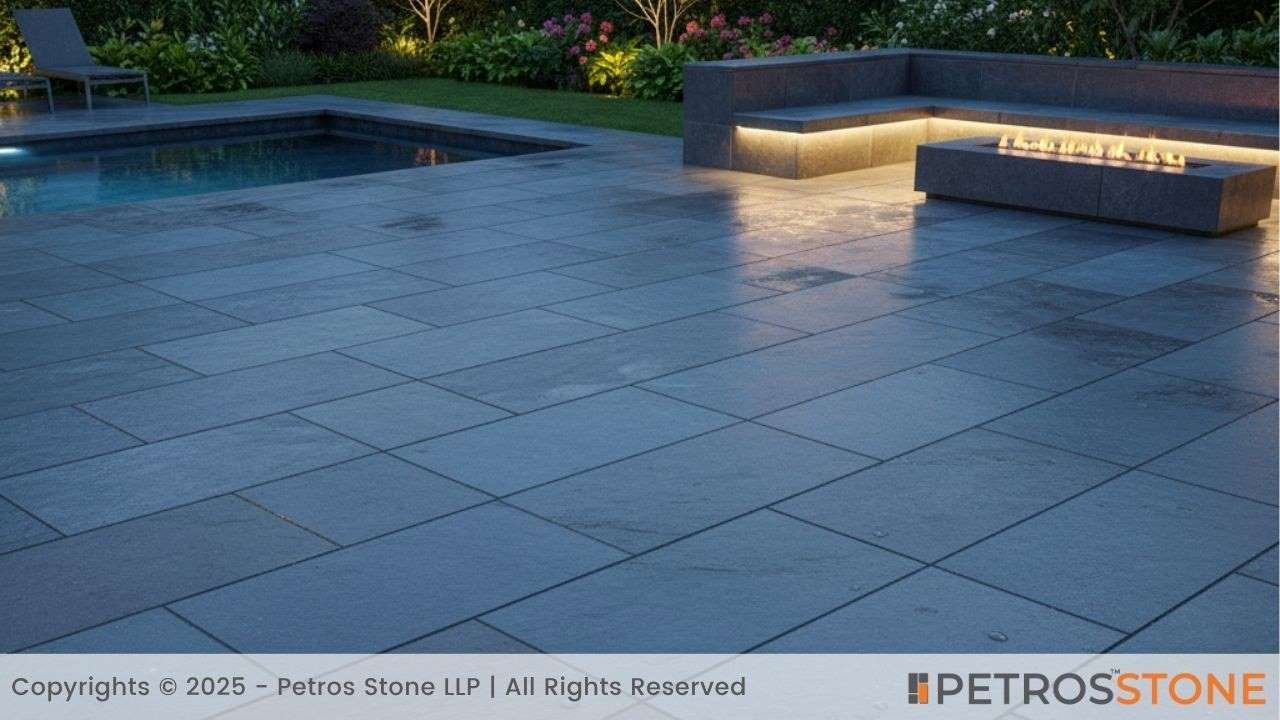
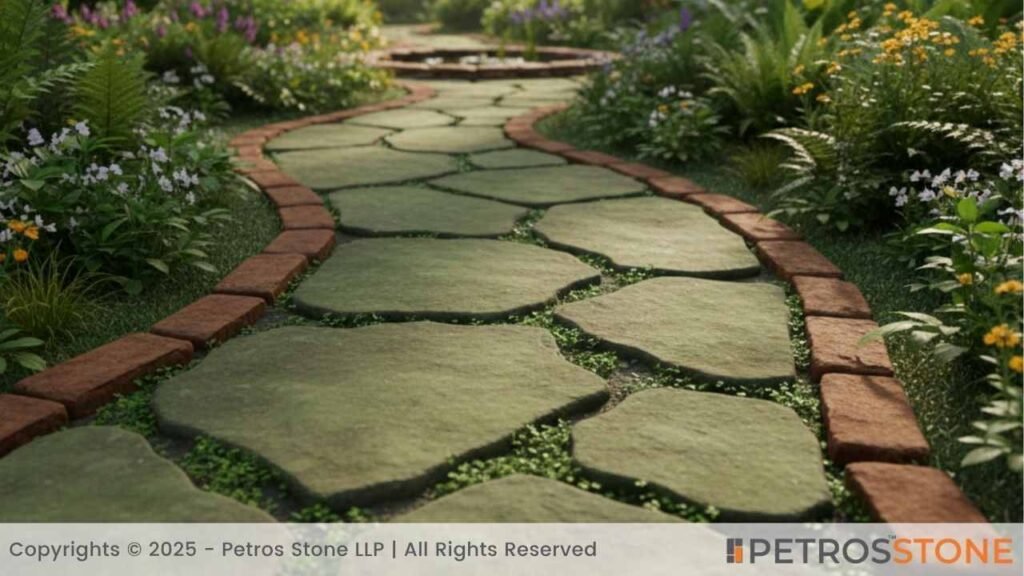
| Project | Stone Type | Design Idea |
| Rustic Patio | Irregular Bluestone | Natural, informal look |
| Modern Garden Path | Rectangular Sandstone | Clean, structured design |
| Poolside Deck | Quartzite | Slip-resistant, elegant |
| Courtyard Layout | Mixed shapes | Artistic, mosaic-style |
| Custom Outdoor Aesthetics | Irregular + Cut | Unique patterns and borders |
Sustainability and Eco-Friendly Aspects
Eco-Conscious Sourcing Practices
- Select suppliers with low environmental impact.
- There is availability of reclaimed or recycled flagstones.
Using Locally Available Stone
- Lessens transportation emissions.
- Supports local businesses.
Integrating Flagstone with Sustainable Landscaping
- Natural drainage using grass joints.
- Blend with native vegetation and rainwater-friendly structures.
Pros and Cons of Different Flagstone Shapes
| Shape | Pros | Cons | |
| Irregular | 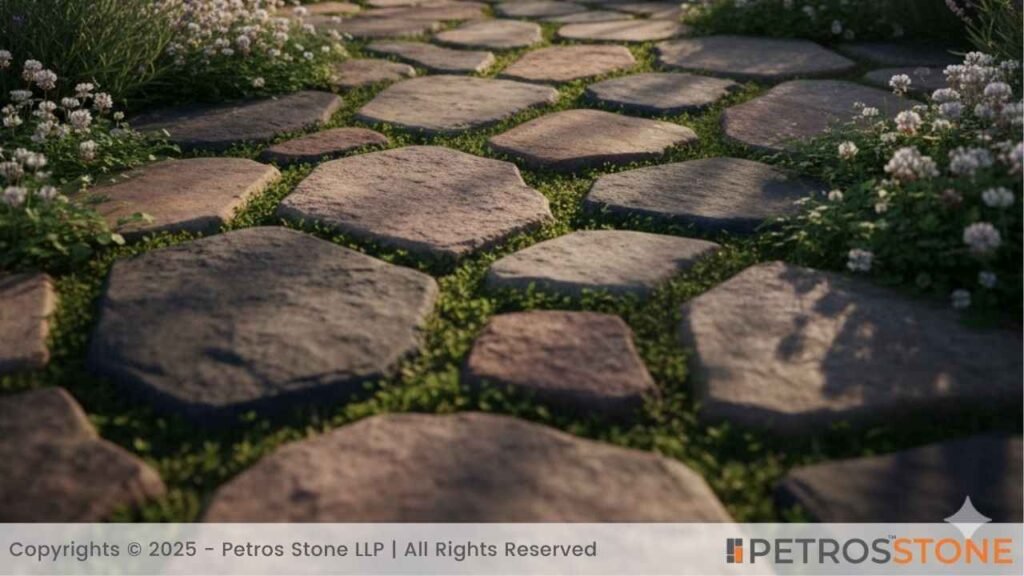 | Flexible design, organic and natural appearance, blends well with landscapes, and allows creative layouts | More installation time, uneven joints, requires careful fitting, may need special jointing material |
| Cut/Rectangular | 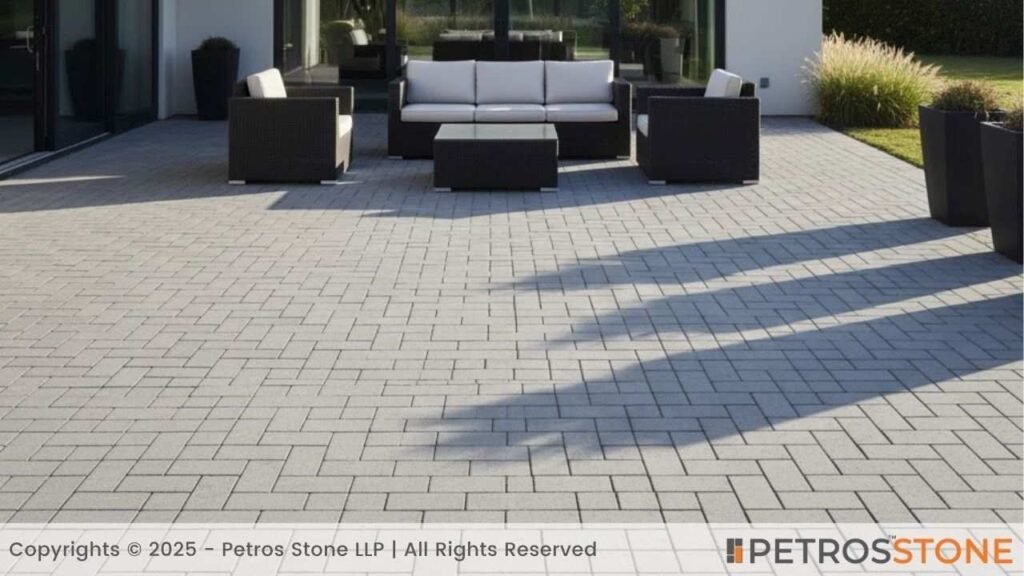 | Easy and faster installation, formal and modern look, predictable pattern, easier to replace individual stones | Less natural, can look uniform or rigid, limited creativity |
| Square | 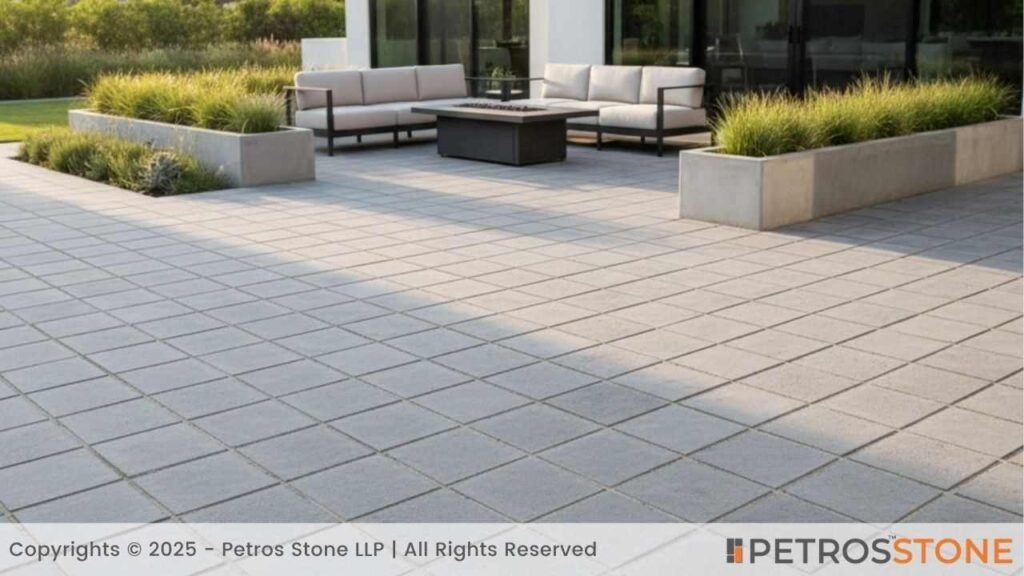 | Clean, geometric appearance, ideal for patios and courtyards, simple to lay in grids | May feel too structured for informal spaces, limited flexibility for curves or odd shapes |
| Custom-Cut | 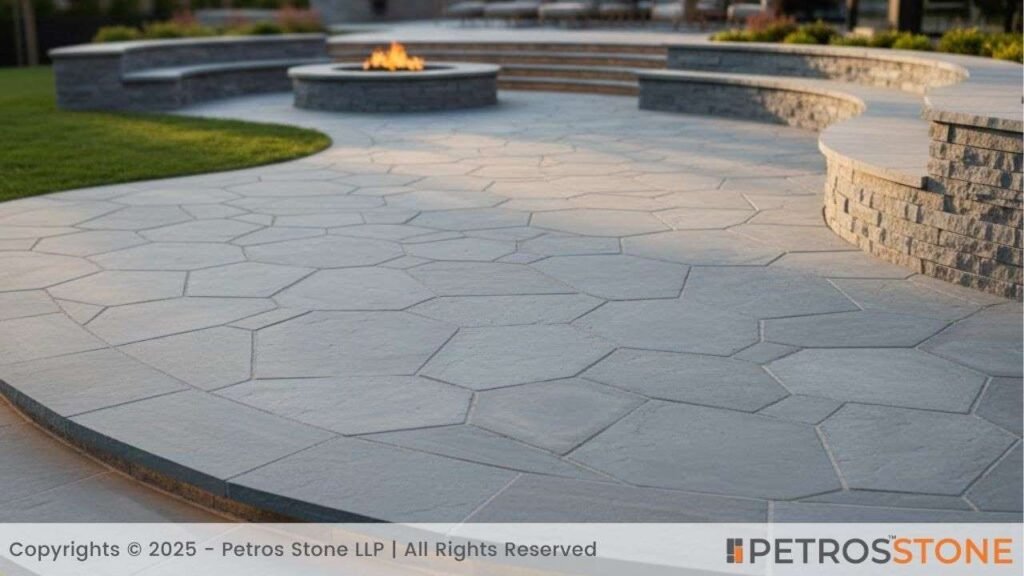 | Tailored dimensions, perfect for unique designs, allow precise fitting | Higher cost, longer fabrication time, may require professional installation |
| Mixed Shapes (Irregular + Cut) | 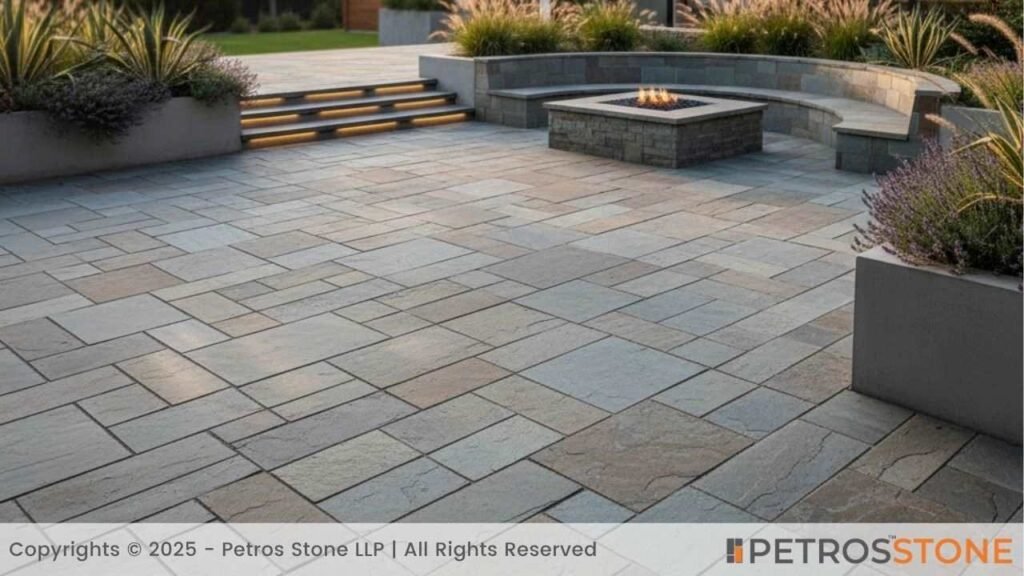 | Combines natural and formal aesthetics, highly creative, visually striking | Complex layout planning requires more time, challenging to maintain uniform joint spacing |
| Small Flagstone Pieces | 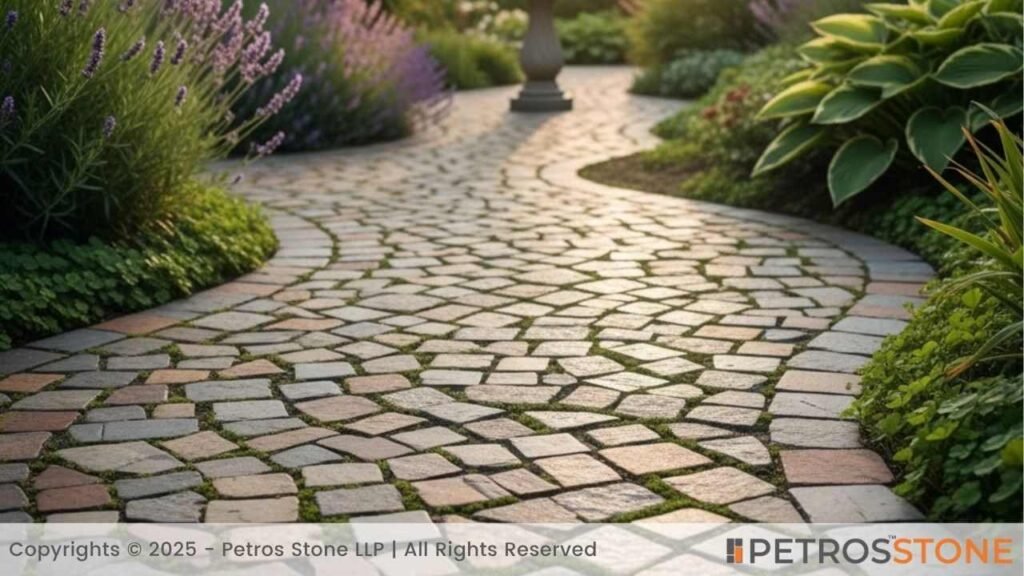 | Good for mosaics and decorative designs, easy to shape around curves, and adds intricate detail | More labor-intensive to lay, higher cost per square foot, may shift if not properly installed |
| Large Flagstone Slabs | 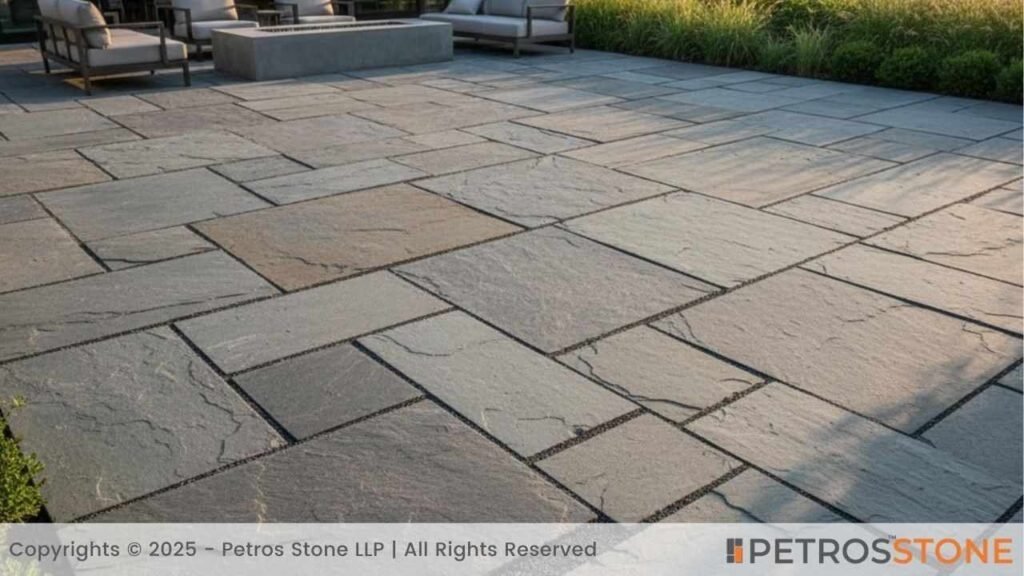 | Fewer joints create a seamless appearance, suitable for high-traffic areas | Heavy and difficult to handle, expensive, and limited flexibility for curved areas |
Expert Tips and Recommendations
- Climate and outdoor use match the flagstone type.
- Consider natural tones to mix with your landscape.
- Plan jointing options carefully.
- Base preparation is not a step to be skipped, as this guarantees durability.
- Seal stones to promote more protection and less maintenance.
Summary
Outdoor flooring flagstone is one of the outstanding options because of its high durability, flexibility, and natural appeal. You like the gravel of the rustic vision of the garden walk, or the fancy pavement of the contemporary garden; flagstone has an inexhaustible variety of designs. Properly installed, maintained, and intelligently designed flagstone flooring can transform any outdoor room not only into a beautiful but also a useful and very durable one.
Key Takeaways
- Flagstone offers natural beauty, durability, and versatility, making it ideal for outdoor spaces like patios, garden paths, pool decks, and courtyards.
- Multiple stone types—such as sandstone, slate, limestone, quartzite, and bluestone—offer unique textures, colors, and performance for various climates and designs.
- Irregular flagstones create organic, rustic looks, while cut or geometric stones suit modern, formal spaces; each comes with its own pros and installation demands.
- Installation methods include dry-laid and mortar-set systems, each with specific cost, durability, and maintenance considerations.
- Design flexibility is high, with patterns like crazy paving, herringbone, grid, and mosaic layouts, offering creative freedom for both DIYers and professionals.
Feel free to get in touch for a free consultation, quote, and get a detailed understanding from our experts here at Petros®. Visit https://petrosstone.com/ or call +91-8446360361 and WhatsApp

Hello!
I’m Dr Mridali, a content writer with a background in dentistry and a passion for turning complex topics into clear, engaging stories. From healthcare to architecture, I create blogs that inform, educate, and connect with readers. With every piece, I aim to blend accuracy with creativity to make information truly valuable.
Brown Granite
White Galaxy Granite
Blue Bahia Granite
Silver Cloud Granite
Black Pearl Granite
Dallas White Granite

